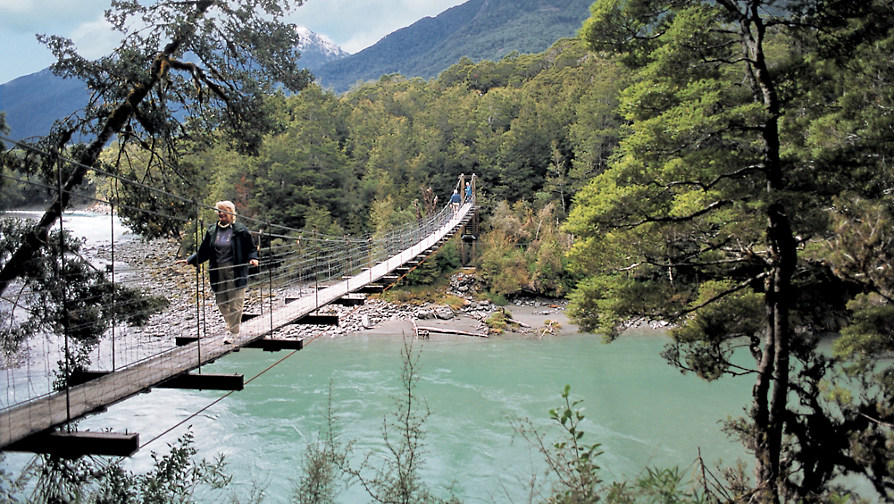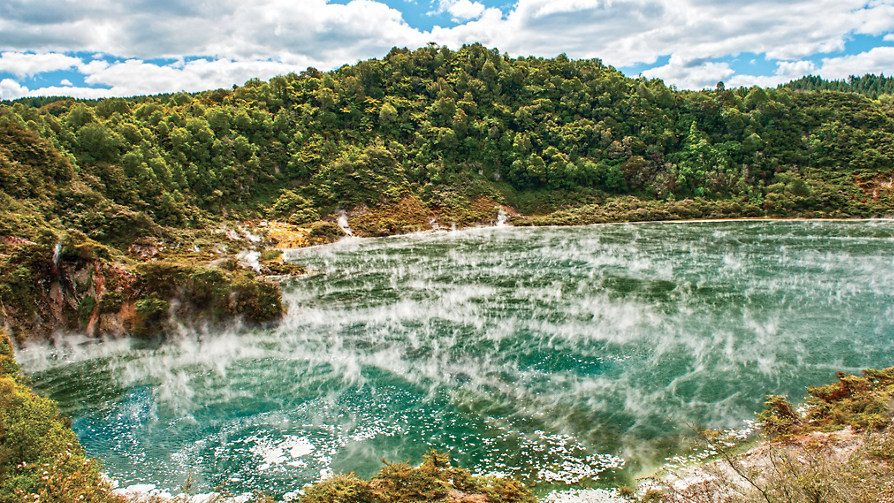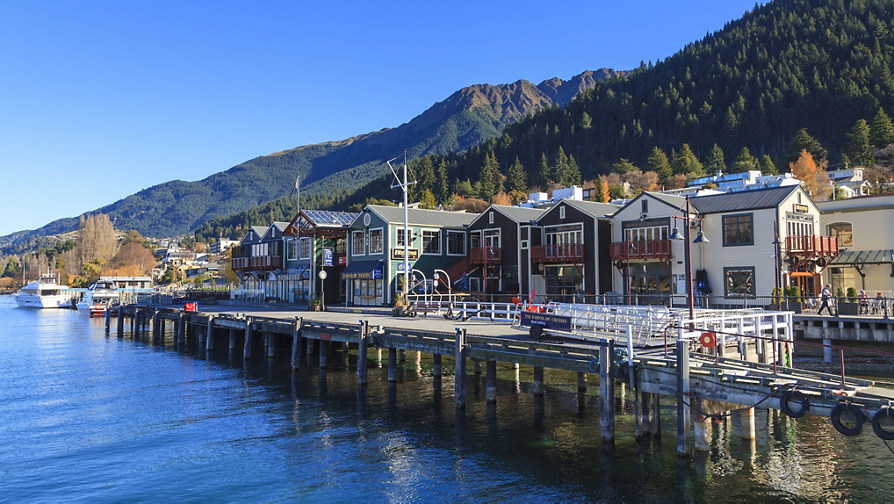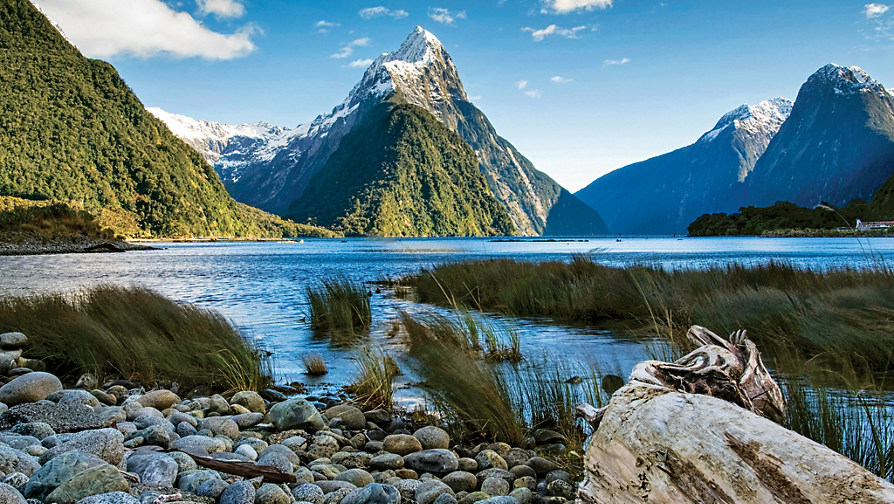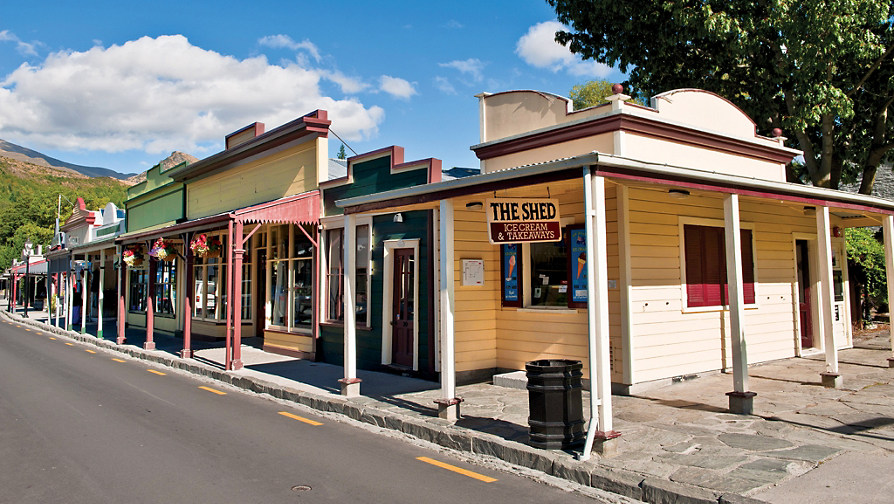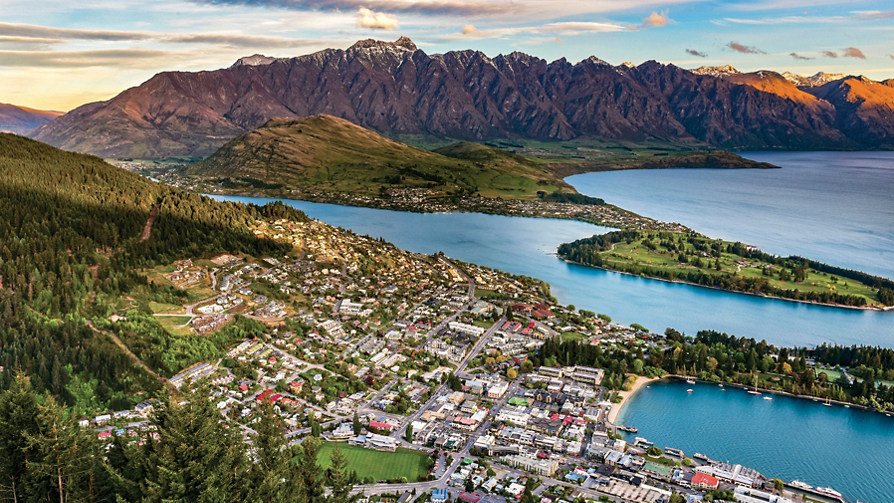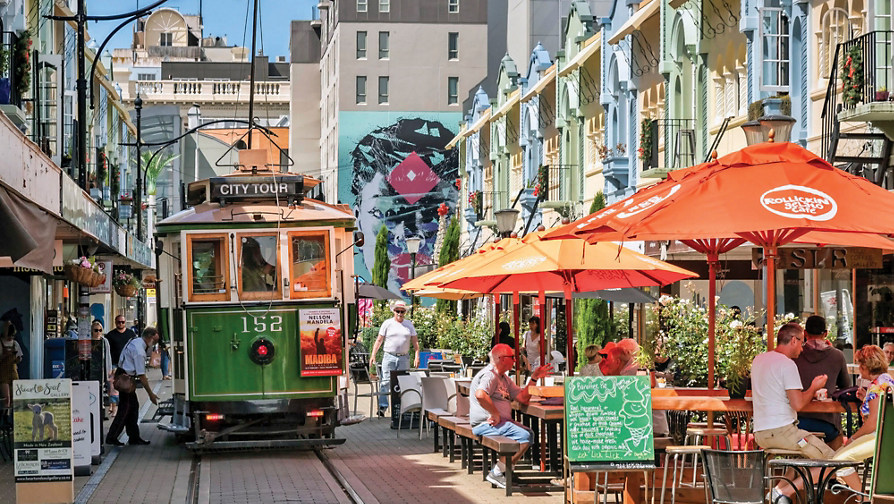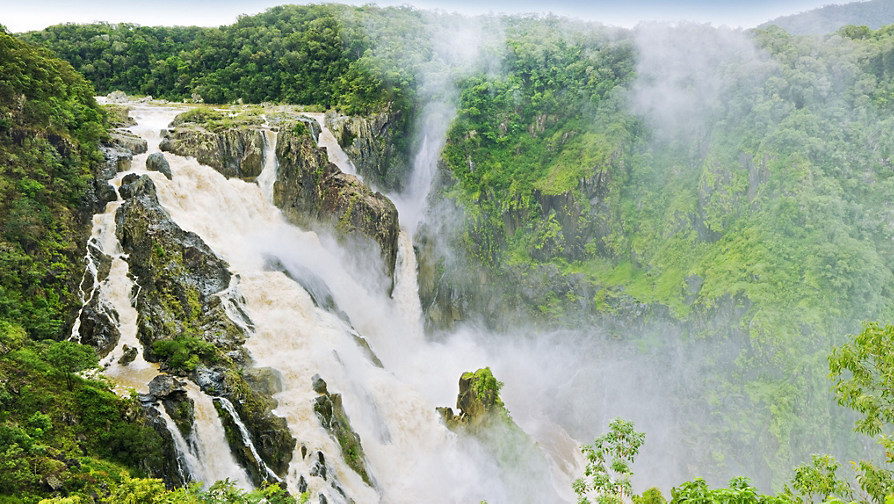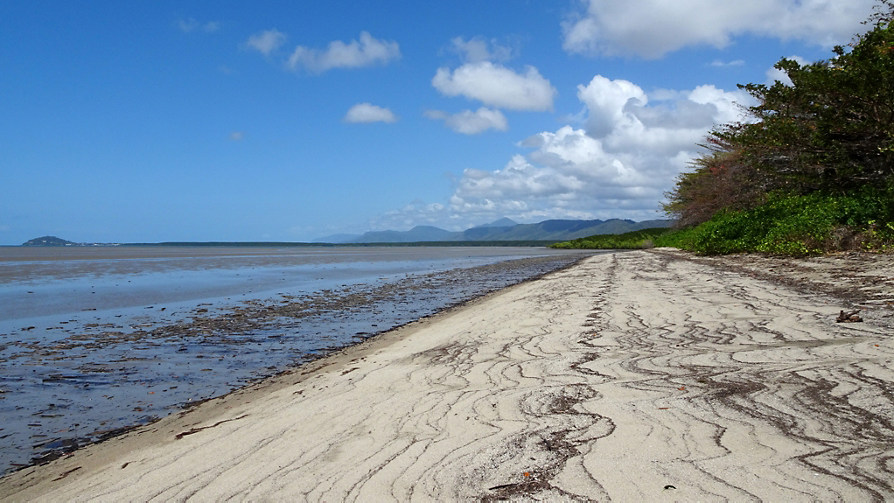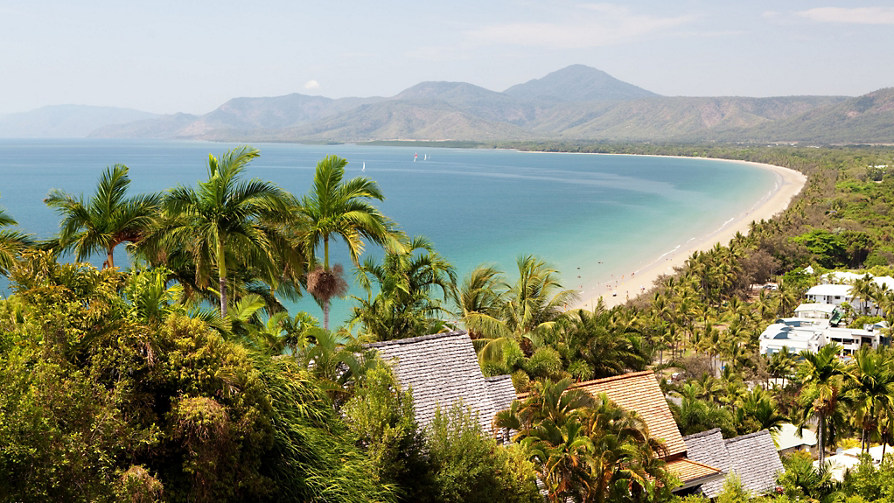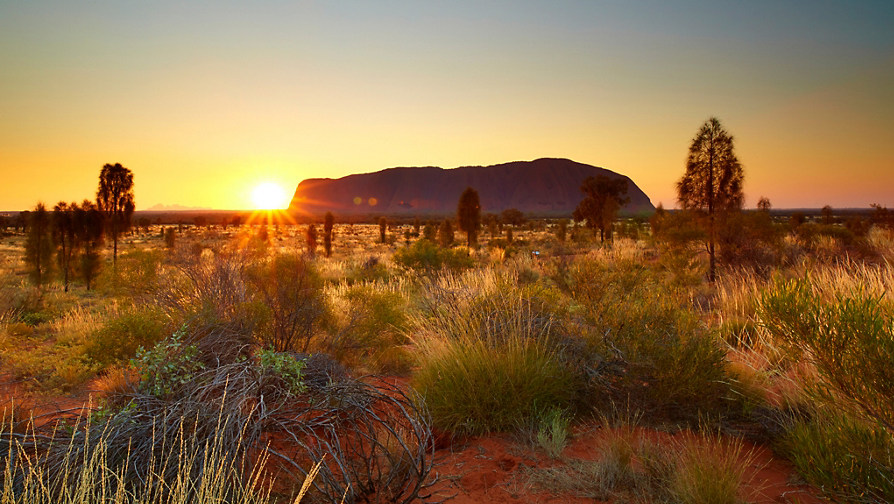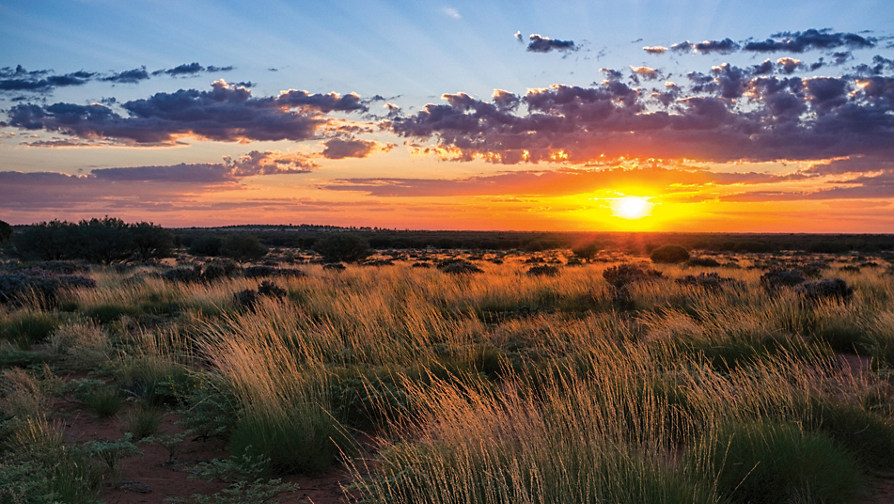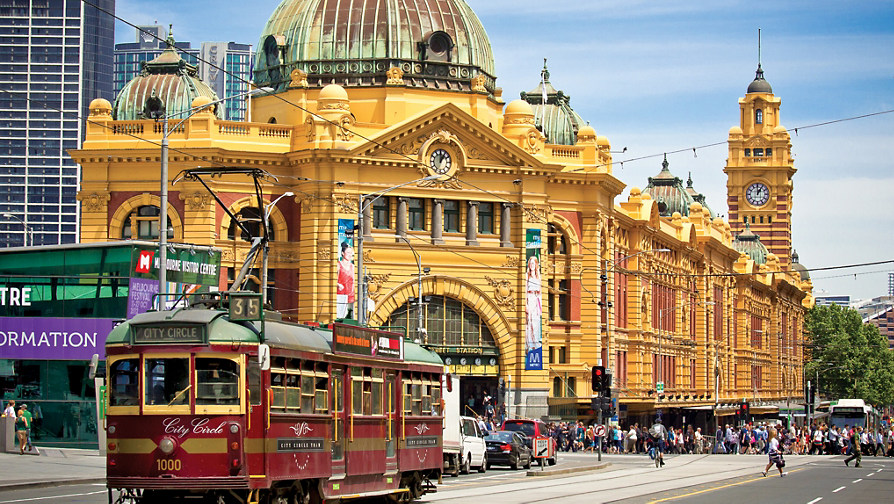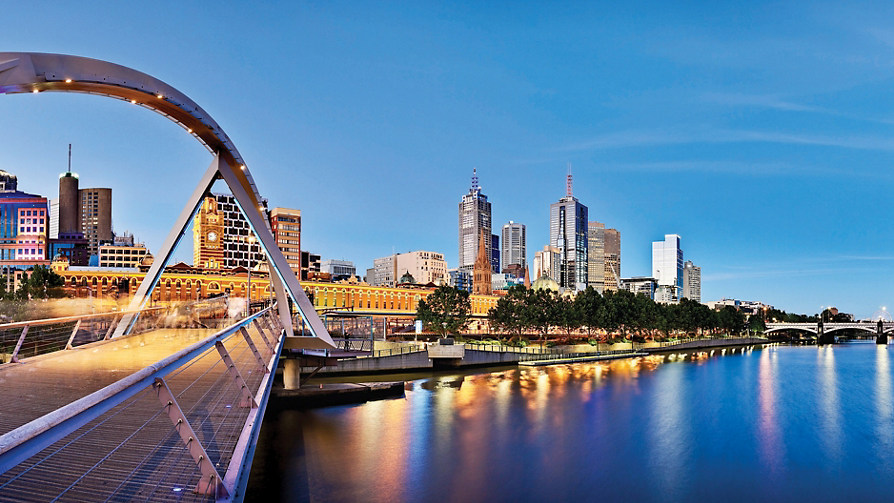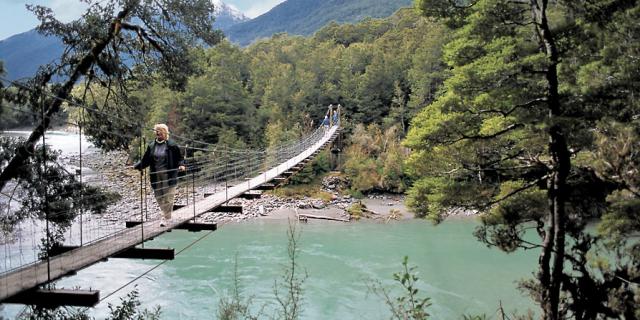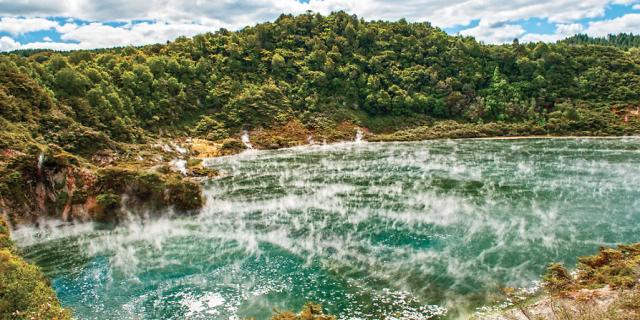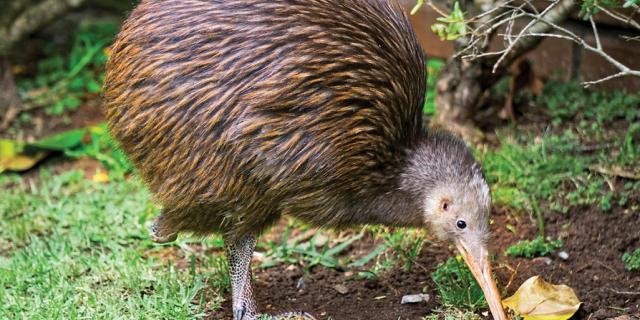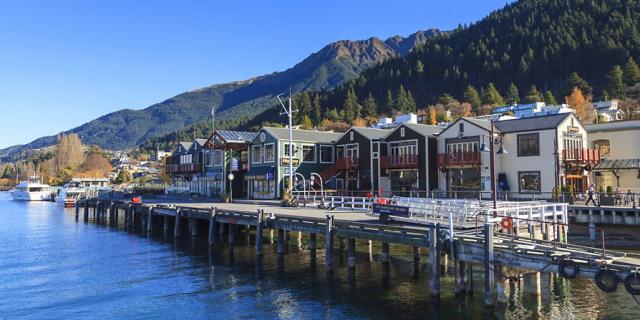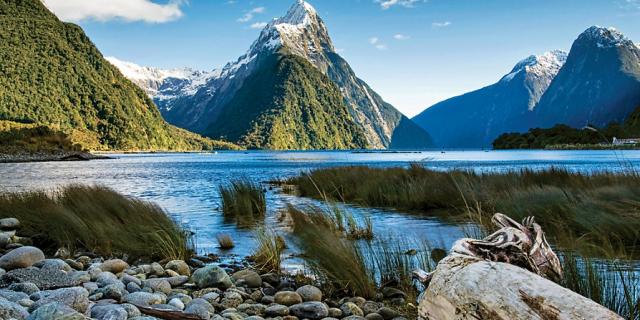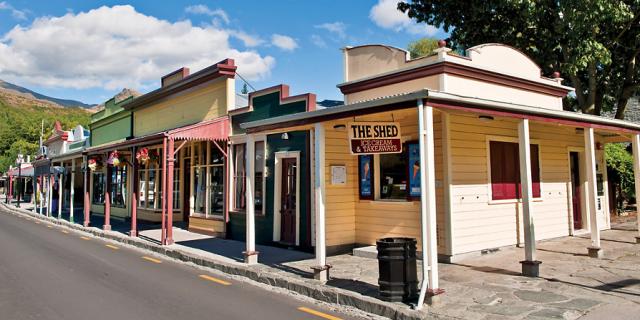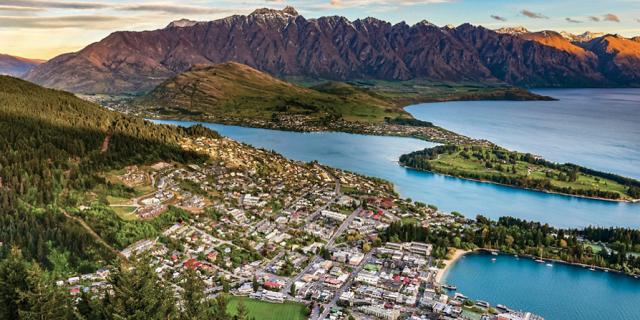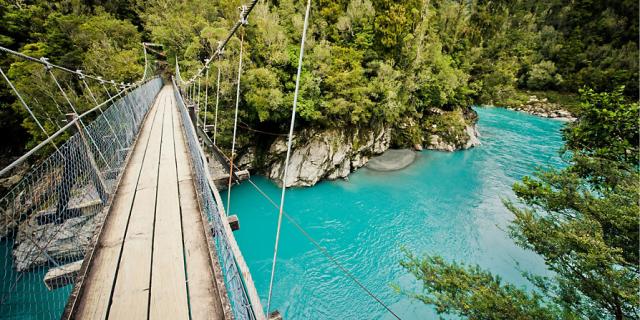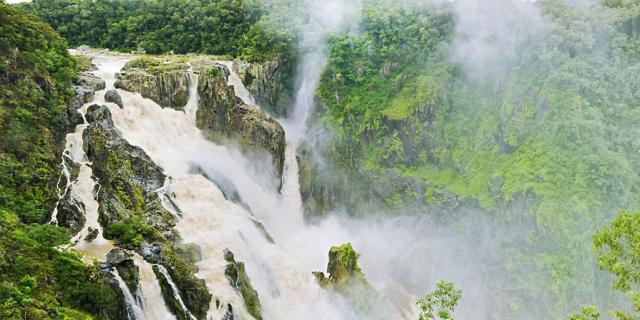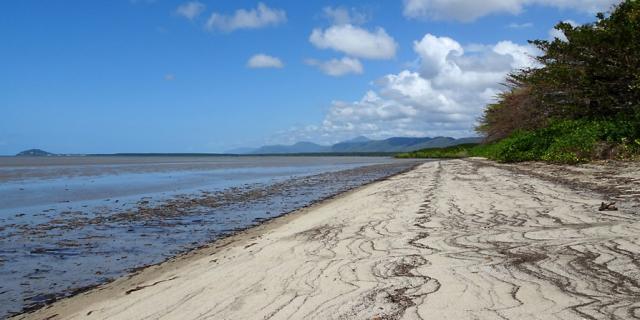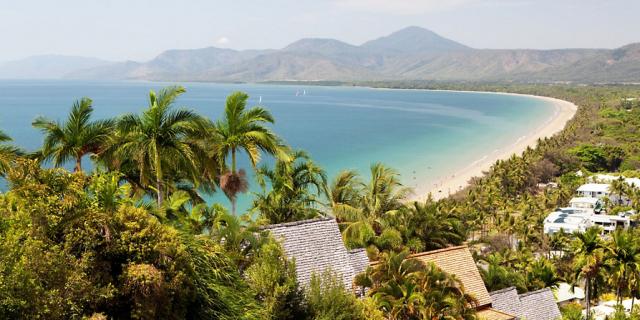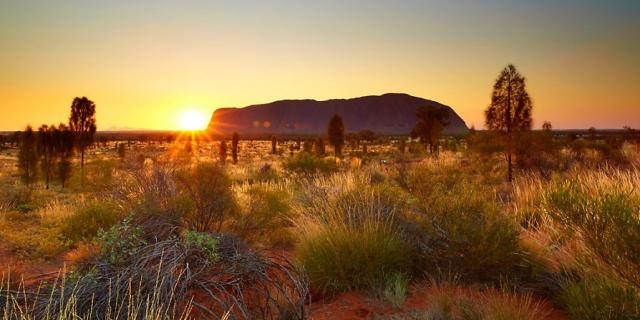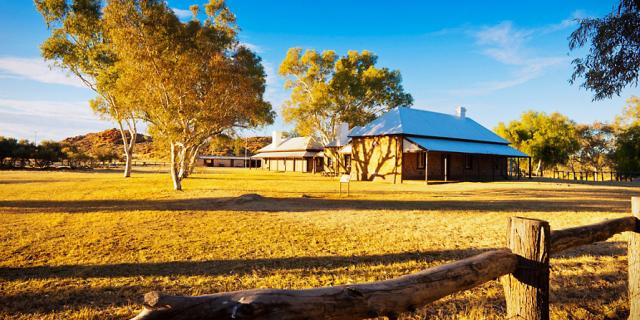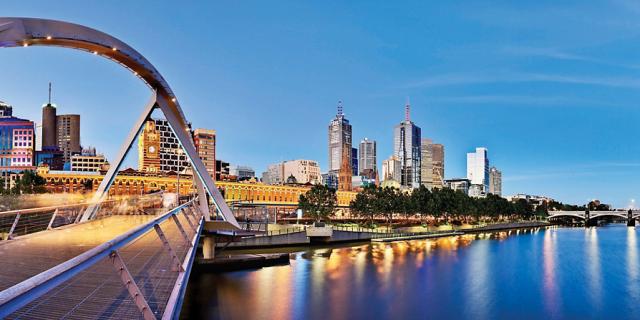- Explore in a small group of 8-16 travelers (average group size of 13)
- All land transportation and 6 internal flights
- Accommodations for 27 nights
- 54 meals—27 breakfasts, 13 lunches, and 14 dinners
- 30 small group activities
- Services of a local O.A.T. Trip Experience Leader
- Gratuities for local guides, drivers, and luggage porters
- 5% Frequent Traveler Credit toward your next adventure
Please note:
Deposit requirement on land trips is $350
Past traveler savings of 5% if you traveled from 2018 onward
New travelers get $100 savings
Australia and New Zealand are lands of stark natural and cultural contrasts. In Australia, dive into the controversial history of the country's original residents, the "First Peoples of Australia"—and in New Zealand, let the Maoris show you their ancient traditions. Thanks to the small group size—just 8-16 travelers, with an average of 13—expert Trip Experience Leaders will connect you with these locals as they invite you into their communities and give you an authentic and in-depth look at what daily life is like in the South Pacific.
Equally as fascinating as the local cultures of Australia and New Zealand is the mosaic of landscapes. Visit modern cities from Sydney to Christchurch, remote sites sacred to Australia's "First Peoples" and Maori people like Uluru and Rotorua, and natural wonders like the Milford Sound. We'll also enjoy an overnight camping experience in the remote Outback and a full day of snorkeling on the Great Barrier Reef. Plus, we'll get a fuller picture of our destination through several Controversial Topics we'll learn about from locals who know about the subject best—from the still-prevalent discrimination of Aboriginal people to the mass bleaching events of The Great Barrier Reef's coral and the use of the often-banned 1080 poison on New Zealand's invasive possum population. We'll also experience what daily life is like in New Zealand when we share a Home-Hosted Dinner with a local family.
Enjoy the best value and save up to $3600 when you explore these two countries in one epic journey Down Under on this comprehensive itinerary.
And whenever you’d like, you have the freedom to explore more of Australia and New Zealand on your own: Break off from the group for independent discoveries—like seeing penguins at St. Kilda or taking the Christchurch Botanic Gardens tour—during free time.
Please note: Due to the length, location changes, long land transfers, distances covered, and both internal and international flights, this is a particularly challenging trip.
DAY 1
Depart U.S.
Fly from the U.S. to Melbourne, Australia.
DAY 2
Cross International Date Line
You continue your flight from Los Angeles to Melbourne, losing one day en route as you cross the International Date Line. You regain this day when you fly back to the U.S. at the end of the trip.
DAY 3
Arrive in Melbourne, Australia
Destination: Melbourne
Accommodations: Jazz Corner Hotel or similar
Activity Note: Throughout your explorations in Australia and New Zealand, you'll interact with local residents—everyone from Aussies and Kiwis to Australia's Aboriginal people and the local Maori. While you'll find some similarities between these different cultures, you'll also discover some distinct differences. We ask that you come to the South Pacific with an open mind to all of these new experiences.
Morning: Most travelers will arrive in Melbourne early this morning to begin your Australia and New Zealand travel experience. An O.A.T. representative greets you at the airport and assists with your transfer to our hotel.
Around 10am, we’ll check in at our hotel. Typically, each of the air-conditioned rooms features a TV, telephone, wireless Internet access (for a fee), a safe, minibar, coffee- and tea-making facilities, and a private bath with a hair dryer. Hotel facilities may include a lounge, restaurant, outdoor swimming pool, and fitness center.
With help from our regional office, we have made our first day in Melbourne a leisurely one, so that you can rest after the long flight here and before we begin exploring the city tomorrow. To help you adjust to the time difference, we spend three nights in Melbourne, the capital of Australia's “Garden State” of Victoria, to give you plenty of time to recharge and truly enjoy the city. You'll have the day free here. You can relax and make use of the hotel’s amenities, visit local shops, or find your own ways to interact with the locals, who are not known for being shy.
Lunch: On your own upon arrival at the hotel—you can enjoy a meal at the hotel restaurant, or your Trip Experience Leader can provide you with a recommendation. You may choose to set off to find a local restaurant that serves regional specialties like emu or balmain bugs—which are similar to lobsters.
Afternoon: Travelers who chose to take our Undiscovered Tasmania: Hobart, Cradle Mountain & Launceston or New! Adelaide & Kangaroo Island: Australian Culture, Charm & Wildlife pre-trip extensions will meet us at the hotel, and around 3:30pm, we gather for a Welcome Orientation briefing. During this briefing, we will introduce ourselves and review our itinerary in more detail (including any changes that may need to occur). Our Trip Experience Leader will also discuss logistics, safety and emergency procedures, and answer any questions we may have. Afterwards, we'll set off on about a 30-minute orientation walk with our Trip Experience Leader, when they will explain the tram network and point out ATMs, the grocery store, and other helpful locations near the hotel.
Dinner: On your own—your Trip Experience Leader will be happy to provide you with recommendations for dinner tonight. After, you may search for a bakery that serves Pavlova, a traditional meringue cake topped with whipped cream and a variety of fresh fruits.
Evening: Your evening is free to rest and relax before our explorations begin tomorrow.
DAY 4
Explore Melbourne • Witness indigenous smoking ceremony
Destination: Melbourne
Meals included: B L D
Accommodations: Jazz Corner Hotel or similar
Activity Note: If you ride the trams today, please remember to use caution when getting on and off the cars. They are a fantastic, romantic way to see the city, but mind the steps, which can be steep or difficult for some travelers to navigate.
Breakfast: Served at the hotel beginning at 6:30am, featuring hot and cold dishes.
Morning: After yesterday's leisurely start, we board our motorcoach and set off around 9:15am. We’ll start our city tour at the Royal Botanic Gardens just before 9:30am where an indigenous guide will lead us through the 19th-century English garden of more than 8,500 flora species, including cacti, roses, and a variety of herbs. Along the way, our guide will share some insights on the native vegetation and their significance to the indigenous people. This knowledge fresh in our minds, we’ll next participate in a traditional smoking ceremony that will last around 20 minutes. This tradition is an indigenous custom in which plants are burned to pay respect to the people’s ancestors and the land. Then around 10:15am, we will sit down with our guide to discuss challenges facing the local indigenous community today. We’ll have around 30 minutes to take part in this conversation, wrapping up around 10:45am.
We’ll have a little free time before climbing back onboard our private motorcoach and departing the Royal Botanic Gardens around 11:30am.
Lunch: Around 12pm at a local restaurant, featuring typical Australian cuisine.
Afternoon: Around 1pm, our Trip Experience Leader will lead us on about a 40-minute discovery walk. During our exploration, we’ll stroll down narrow laneways to get unique views of the city.
Our walk will end around 2pm at Bourke Street, a bustling shopping street lined with chic stores and small cafés. For the remainder of the afternoon, you are free to explore the city on your own. Melbourne is a city of broad boulevards, green parks, and Victorian architecture, whose growth in the late 19th century was fueled by a gold rush. Public trams running on rails criss-cross the city, as distinctive a symbol of Melbourne as cable cars are of San Francisco.
Perhaps you’ll take a boat ride on the Yarra River from Princes Walk, or hop on a tram to the suburb of Fitzroy and stroll along lively Brunswick Street with local artists and musicians. Cross the Yarra to Southbank to shop and dine. Stroll more of Melbourne's magnificent parks, like Flagstaff Gardens, Carlton Gardens, and the King's Domain. Or simply return to the hotel to relax if you wish.
Around 5:45pm, we'll reconvene at the hotel to walk about 15 minutes to a local restaurant.
Dinner: At about 6pm, we'll enjoy a Welcome Dinner. This is a great chance for you to mingle with your travel companions at a local restaurant serving modern Australian cuisine.
Evening: Free for your own discoveries. You can take some time for yourself, explore the surrounding area, or meet up with fellow travelers to discuss the day.
DAY 5
Melbourne • Optional Dandenong Ranges tour
Destination: Melbourne
Meals included: B
Accommodations: Jazz Corner Hotel or similar
Breakfast: Served at the hotel, featuring hot and cold dishes beginning at 6:30am.
Morning: Make your own independent discoveries during our last day in Melbourne. Perhaps you'll venture to the Melbourne Museum to trace the natural history of the area. Here, you can view dinosaur fossils and taxidermy animals. Or, if you are more interested in contemporary art, you can visit the Justin Art House Museum where the owners have been collecting pieces for around 40 years.
Or, join us on an optional tour to the Dandenong Ranges. A natural oasis located just an hour outside of Melbourne, the Dandenong Ranges offer visitors a tranquil escape from the bustling city with its fern gullies, mountain ash forests, quaint artists’ villages, and unique gardens. We’ll depart the hotel via private motorcoach at around 9am, arriving at around 10am. Once we arrive, we’ll delve into the sprawling park’s delights—beginning with an exploration of the magical William Ricketts Sculpture Sanctuary.
Along with a local guide, we’ll wander through fern-blanketed glades and lush woodlands, discovering the sculptures of artist William Ricketts—92 in all—which blend seamlessly into their natural surroundings, some even covered in moss. Born in 1898, Ricketts found his inspiration in the natural world around him as well as the Aboriginal people whom he spent time with during his travels in Central Australia. He believed all people should be stewards of the Earth—a role he felt the native people exhibited perfectly.
Next, around 11:30am, we’ll ascend 2,077 feet above sea level to Dandenong’s Sky High Lookout for a sweeping view of the region below. Then, depending on your departure, we’ll take our private motorcoach back down to either Olinda or Sassafras, each small town a haven for local artists.
Lunch: On your own—your Trip Experience Leader can recommend some of their favorite options. You may want to search for an Aussie-style hamburger, which is similar to a western-style burger except locals add beetroot as a topping.
Or, if you have embarked on the optional tour, enjoy an included lunch at a local café around 1pm.
Afternoon: On your own—perhaps you'll visit Cook's Cottage to see where James Cook lived. Considered to be one of Australia's oldest buildings, this charming structure was built by Cook's parents in the 18th century in England, and was transferred to Melbourne in the early 20th century. Or, you may step aboard the Polly Woodside, a ship that has seen more than a million miles of travel since its construction in the 19th century.
Or, if you have joined our optional tour, you'll continue to explore the small artist's village after lunch concludes around 2:30pm. Then around 3pm we’ll board our private motorcoach and drive back to the hotel, arriving around 4pm.
Dinner: On your own—ask your Trip Experience Leader for suggestions. Perhaps you’ll try a traditional Australian-style meat pie, served alongside a simple green salad.
Evening: The remainder of the evening is free. Ask your Trip Experience Leader for recommendations if you’d like to experience this city at night.
Dandenong Ranges - $140/person
A natural oasis located just an hour outside of Melbourne, the Dandenong Ranges offer visitors a tranquil escape from the bustling city with its fern gullies, mountain ash forests, quaint artists’ villages, and unique gardens. While there, we’ll delve into the sprawling park’s delights—beginning with an exploration of the magical William Ricketts Sculpture Sanctuary. Along with a local guide, we’ll wander through fern-blanketed glades and lush woodlands, discovering the sculptures of artist William Ricketts—92 in all—which blend seamlessly into their natural surroundings, some even covered in moss. Born in 1898, Ricketts found his inspiration in the natural world around him as well as the Aboriginal people whom he spent time with during his travels in Central Australia. He believed all people should be stewards of the Earth—a role he felt the native people exhibited perfectly.
Next, we’ll ascend 2,077 feet above sea level to Dandenong’s Sky High Lookout for a sweeping view of the region below. Then, depending on your departure, we’ll take our private motorcoach back down to either Olinda or Sassafras, where we will enjoy lunch before exploring the small village.
DAY 6
Fly to Alice Springs
Destination: Alice Springs
Meals included: B L
Accommodations: DoubleTree by Hilton Hotel Alice Springs or similar
Activity Note: As we journey into the Australian Outback, be prepared for extreme temperatures, which can exceed 100°F during the day and drop dramatically at night, sometimes reaching as low as 40°F.
Breakfast: Served at the hotel featuring hot and cold dishes beginning at 6:30am.
Morning: Around 7am, we'll board our coach for the 1-hour transfer to the airport where we'll catch a nearly 3-hour flight to Alice Springs, located in the Outback. As we fly over Australia's "red centre," we'll see a sprinkling of remote towns, and an arid expanse of red dirt and desert flora from above. During our time in the Outback, our local Trip Experience Leader will provide their expertise on the region to help us see how the geography and culture differ from that of Australia's big cities.
We arrive around 11:30am and then begin our transfer to Telegraph Hill with a stop at ANZAC Hill Lookout. From this vantage point, we’ll enjoy sweeping panoramic views of Alice Springs and the beautiful surrounding ranges. Afterwards, we’ll continue on our way, stopping first for lunch.
Lunch: We’ll enjoy an included lunch around 12:15pm at Telegraph Station, which offers a selection of sandwiches, coffee, desserts, and other café staples that are made daily on-site.
Afternoon: Afterwards, we set off on a tour of the Telegraph Station. Our tour will begin around 1pm and last about 45 minutes. The station marks the European settlement of Alice Springs at the inception of the Overland Telegraph Line, which was established in 1872 to relay messages between Adelaide and Darwin, its neighboring town.
Following our tour, we depart for our hotel. Along the way, we will have the opportunity to stop and buy any last-minute provisions for our overnight stay in the Outback. At about 3pm, we’ll check in to our hotel where you will have some time to relax for a little over an hour. Typically, each of the air-conditioned rooms has a balcony, refrigerator, minibar, and private bath. Amenities may include a 24-hour fitness center, pool, sauna, tennis court, and three on-site eateries.
At about 5:30pm, we'll reconvene in the hotel for an approximately 1-hour lesson on how to play the didgeridoo, an indigenous musical wind instrument, with local musician Andrew Langford—known internationally as an expert in didgeridoo history and performance. The first didgeridoos, played by indigenous people in northern Australia approximately 40,000 years ago, were made from fallen eucalyptus branches that had been naturally hollowed out by termites. Today, these instruments are typically made of eucalyptus, bamboo, or agave.
During this lesson, we will learn about the differences in contemporary and traditional sounds and techniques. Andrew will also share with us his passion for the didgeridoo, and how his commitment to his practice has led him to become one of the most sought-after didgeridoo players in the world.
Dinner: On your own around 6pm—you may try one of the hotel’s restaurants or venture into the town center for a local dining experience. Ask your Trip Experience Leader for suggestions.
Evening: You’ll continue enjoying your free time into the evening. Perhaps you’ll take a dip in the hotel pool or enjoy a drink with your small group.
DAY 7
Overland to the Outback • Controversial Topic: Systemic Victimization of Aboriginal Australians with Lindsay Watson • Begin remote Outback Camping experience
Destination: The Outback
Meals included: B L D
Accommodations: Private Tented Camp
Exclusive O.A.T. Activity: Today we will discuss the Controversial Topic of systemic victimization against Aboriginal Australians with Aboriginal elder Lindsay Watson. Mr. Watson will share his family’s and his own personal experiences of discrimination at the hands of “white fellas,” or non-indigenous Australians, as well as tell us the history of atrocities his people have faced for generations. This difficult conversation will give us a fuller picture of Australia and bring us closer to those who call it home. Read more about this topic below.
Activity Note: Today, our transfer from Alice Springs to our O.A.T. Private Tented Camp will involve a long bus ride, covering approximately 270 miles, over roads that may be bumpy, uneven, and winding. Our total transfer time is up to nine hours, with stops along the way. As we journey deeper into the Australian Outback, temperatures will remain extremely hot, often exceeding 100°F during the day and dropping dramatically at night, sometimes reaching as low as 40°F.
Breakfast: Served at the hotel beginning at 6am, featuring hot and cold dishes.
Morning: Around 8am, we board our bus to begin our journey deep into the Australian Outback for our remote camping experience—a recently added feature. Including stops along the way, the entire transfer will take about nine hours. Our first stop, around 8:30am, brings us to Simpsons Gap, one of the most prominent gaps piercing the West MacDonnell Mountain Range. We will have about an hour to explore this scenic area, where towering red cliffs surrender to an open waterhole, and rust-hued walking paths lead us through large stands of mulga trees and witchetty bushes.
Joining us for our explorations is Lindsay Watson, elder of the Aboriginal Meintangk people of South Australia. During our visit, we will have a discussion with him about the cultural significance this gap has within his community, and how storytelling—known as Dreamtime stories—is strongly woven into their culture. In a group as small as ours, this is a great opportunity to ask questions, and come away from the discussion with an in-depth understanding of this region’s history and culture.
We will also delve into the Controversial Topic of systemic victimization against Aboriginal people by “white fellas”—slang for non-Aboriginal Australians. As Mr. Watson will tell us, the relationship between indigenous and non-indigenous Australians was and continues to be fraught and complex. In fact, Aboriginal Australians continue to fight for equal rights and respect to this day. While the government is working to improve these issues, they can be complicated and daunting, and can be traced back to the arrival of the First Fleet to Australia.
Mr. Watson will share his views on discrimination by speaking of past atrocities such as slavery; the Stolen Generation; and the Coniston Massacre of 1928, the last known officially sanctioned massacre of indigenous Australians, resulting in the murder of over 60 Aboriginal people throughout the Central Desert region. This history of racism still feels very raw for Aboriginal people like Mr. Watson, whose mother-in-law was a victim of the Stolen Generation—a period between 1910 and the 1970s when Aboriginal children were removed from their families by force as part of Australia’s former policy of assimilation. Some of her family members died in the Coniston Massacre as well. As for his own experiences, Mr. Watson was born and raised in Kingston SE yet lived the first years of his life in what was known as Blackford Reserve—about ten miles out of town as “black fellas” (Aboriginal people) were not allowed to live in town. He was 4 years old when they were finally allowed to move into Kingston SE itself. Today, he lives in Alice Springs with his partner Tanya who is one of the Arrernte people, an Aboriginal group from the Central Australia region.
From Mr. Watson’s perspective, discrimination against Aboriginal Australians is still happening today—as seen in the way the local Arrernte people are treated by the community’s police force, justice department, and welfare system. Recent data has shown that since 1991, 434 Aboriginal inmates have died custody, yet agencies such as police watch-houses, prisons, and hospitals failed to follow all of their own procedures in 41% of cases where Aboriginal people died.
Still, there is cause for hope for the future: In the 1990s, Australia set up a ten-year policy of reconciliation aimed at developing a better relationship between Aboriginal people and the wider Australian community. Then in 2008, the Closing the Gap campaign was created for the Australian governments to work together to deliver better health, education, and employment opportunities for Aboriginal people, and to eliminate the gap between Indigenous and non-Indigenous Australians. Mr. Watson meanwhile has spent the majority of his life working for and with his fellow indigenous countrymen, such as acting as manager of Language Education and Training for local Aboriginal people. He also raises awareness of his culture through his art and has been conducting cultural tours for the past 17 years.
During our one-hour conversation, we’ll have about 40 minutes to ask Mr. Watson any questions we may have. Afterwards, we will board our bus again around 9:30am to set off for our transfer to our next stop, Ormiston Gorge, arriving around 11:15am. These red cliffs are dotted with dense flora and fauna, making it a natural sanctuary for regional plant and animal species. In fact, the central rock-rat, a mouse native to the MacDonnell Range and first scientifically recorded in 1896, was seemingly nonexistent for a century until its rediscovery here in 1997.
We will spend about 45 minutes here, exploring the wildlife, or perhaps going for a swim in the waterhole—which may be ideal as temperatures tend to reach their highest point around this time of day.
Lunch: A picnic-style lunch around noon will be served at Ormiston Gorge, featuring an assortment of picnic foods.
Afternoon: Around 12:30pm, we will depart our picnic site to complete the longest part of our transfer. The remainder of our drive will take up to four hours with comfort stops as needed along the way, as we are getting deep into the true Australian Outback. Far removed from the tourists and big cities, we’ll drive past flat, sweeping desert vistas with native bush fringing the red-dirt road. This is a great opportunity to spot animals endemic to the region, such as emus or kangaroos.
Upon arrival at our campsite around 4:30pm, we will be greeted by a camp host to welcome us to our home for the night. There will be snacks, such as cheese, crackers, fruit, and wine available. You may choose to sit with fellow travelers to enjoy the views and snacks, or retire to your tent to unpack.
Our campsite is exclusive to our O.A.T. group and is set among the natural bush. At the camp, you’ll stay in a walk-in canvas tent, complete with two cots. There are shared toilet and shower facilities with running water and a dining area in the common space. The accommodations are simple, yet comfortable, and as night falls, the paths to our shared bathrooms will be illuminated by lights.
Around 6pm, we will gather for a viewing of the sunset. As the sun goes down, you have the possibility of viewing native species, such as dingoes, black cockatoos, and other regional bird species. Temperatures will fall dramatically as night approaches, and following our viewing, we will gather for dinner under the stars.
Dinner: We will enjoy a traditional Australian barbecue dinner at the main dining area around 6:30pm.
Evening: The evening is free for you to enjoy the starry desert sky. Perhaps you’ll sit around the bonfire with your fellow travelers, or maybe retire to your tent. Tonight, you will have the opportunity to sleep under the stars in an authentic Australian swag—a portable bedroll for outdoor sleeping—to experience a one-of-a-kind Australian Outback experience. The stars you’ll witness are quite different from the night sky at home—here you’ll be treated to views of the Southern Hemisphere, including scores of constellations only visible from this side of the world, including the Southern Cross.
DAY 8
Outback • Kings Canyon • Overland to Uluru (Ayers Rock)
Destination: Yulara/Ayers Rock
Meals included: B L D
Accommodations: Desert Gardens Hotel or similar
Activity Note: Our morning in Kings Canyon features hiking along nature trails for three hours or more (weather dependent) and involves walking up and down hills. Suitable for people looking for and capable of a strenuous hike, the first half of the Rim Walk is the most challenging with uneven and sometimes steep rocky inclines, but the view from the top is what will really take your breath away. Travelers who do not wish to participate may opt for easier hiking trails. If you are unsure whether or not you should participate, please speak with your Trip Experience Leader and your local guide, as they can give you further insight into this demanding activity.
Our transfer to Uluru will involve a 3- to 4-hour bus ride over roads that may be bumpy or uneven at times. We will break up the long transfer with stops along the way.
Breakfast: Around 5am at our campsite, featuring assorted options, such as croissants, cereal, fruits, coffee, and tea.
Morning: We will depart our campsite early around 6am to take advantage of the cooler temperatures before the sun rises and drive approximately 30 minutes to Kings Canyon. Upon arrival, we will set out on a 3-hour guided walk of Kings Canyon. It’s a challenging hike up the high sandstone walls of the canyon—particularly the first half which consists of uneven, rocky and sometimes steep inclines, but we’ll be rewarded for our efforts: From rugged ranges of desert terrain hugging forests of palms, to plunging chasms that seem to collide with the canyon floor, this hike offers views that stretch across the desert and showcase the diversity in this landscape.
For those looking for an easier walk, there are other trails along the base of the canyon, which lead you through ferns and eucalyptus to towering views of the canyon walls.
Around 9:30am, we depart Kings Canyon and drive about 30 minutes to Kings Creek Station, a working cattle station.
Lunch: Around 10am at the station featuring sandwiches, salads, and fruit.
Afternoon: Following lunch, around 11am, we’ll board our private motorcoach and begin our drive to Ayers Rock. Our transfer today will take up to 4 hours, but we have built in stops to break up this long transfer. Around 1pm, we will stop at Curtin Springs Station, a cattle ranch, to stretch our legs for about 20 minutes before continuing our journey.
We’ll arrive around an hour later in the small town of Yulara, just a short drive from Uluru National Park. This accommodation reflects sensitivity toward the environment with its landscaped desert setting and offers a swimming pool, restaurant, and bar. Each air-conditioned room features coffee- and tea-making facilities, in addition to a refrigerator, minibar, and private bath. We will check in to the hotel around 2:30pm, and you will have some time to settle in and relax from our overland transfer.
Dinner: Around 6pm at our hotel.
Evening: Your evening is free to walk the hotel grounds or take advantage of its amenities.
DAY 9
Uluru (Ayers Rock) • Kata Tjuta National Park • Sunrise and sunset viewings
Destination: Yulara/Ayers Rock
Meals included: B L
Accommodations: Desert Gardens Hotel or similar
Early Morning: Rise early this morning to witness Uluru in the light of dawn, a dramatic sight seen by far fewer travelers than at sunset.
Breakfast: Served at the hotel featuring hot and cold dishes beginning at 6am.
Morning: Around 9am, we’ll depart the hotel by motorcoach to discover Kata Tjuta National Park. While Uluru is the centerpiece of Kata Tjuta, the park also includes the spectacular rock formations nearby called the Kata Tjuta. Our Trip Experience Leader will give us more insight into the spiritual symbolism of this natural wonder and the history of the indigenous people's rights to the land. Following our guided tour, we will drive back to the hotel, departing around 11:15am.
Lunch: We’ll arrive back in Yulara around 12pm and get a "take-away" lunch from the Kulata Academy Café, an establishment that employs young indigenous people as trainees to prepare them for a career in the hospitality industry.
Afternoon: After lunch, we’ll walk 5 minutes back to our hotel to enjoy a few hours of leisure time to settle in or explore on your own. We’ll then reconvene in the hotel lobby around 4:30pm to board our private motorcoach and drive 15-minutes to a sunset viewing area. Here, we’ll enjoy a traditional sunset toast as the last daylight paints the massive monolith of Uluru into a kaleidoscope of colors. Our private guide will lead our small group around areas of the base of the massive sandstone monolith that are rarely visited by tourists. As we explore, our guide will point out the effects of millions of years of erosion by rain and wind.
Early European settlers named it Ayers Rock, but it is called Uluru by the Anangu indigenous people who serve as its spiritual caretakers. In spite of—perhaps even in defiance of—the negative effects of European settlement, some 50,000 years of Australian indigenous culture and spirit have strongly endured in art, dance, and music. Uluru is the most fitting symbol of that endurance.
The local Anangu people attach paramount spiritual significance to Uluru. As the Outback sun descends on the monolith (whose red-orange hue shifts fluidly throughout the day) the rock seems to glow eerily, as if lit from within. For centuries, people have felt the ancient spirituality of Uluru. The Anangu consider Uluru a literal giver of life as it attracts animals in abundance to its waterhole and provides shelter and firewood to visitors. All in one rugged place and where one might freely describe it as "the middle of nowhere," you can find a variety of life prospering.
This viewing will provide us with a deeper understanding of the indigenous heritage that runs deep in this land and all of Australia. During our explorations, our local Trip Experience Leader will put things into perspective and help us understand the connection the indigenous people have to this sacred site. Much of the area around Uluru is open for public visitation, but parts of this site are still so important to the Anangu that they remain off-limits.
After our sunset viewing, we will drive back to the hotel.
Dinner: On your own—you may choose to venture out in search of a traditional restaurant. Or, you may dine in the hotel's restaurant, which features dishes that showcase indigenous flavors, like native spices, seeds, grains, and fresh local produce.
Evening: Your evening is free to walk the hotel grounds or take advantage of its amenities.
DAY 10
Fly to Cairns • Transfer to Port Douglas
Destination: Port Douglas
Meals included: B D
Accommodations: Oaks Port Douglas Resort or similar
Breakfast: Served at the hotel featuring hot and cold dishes beginning at 6am.
Morning: At leisure. You may wish to relax, use the hotel's amenities, or prepare for the next leg of our journey.
Lunch: On your own. Dine in the hotel’s restaurant, or ask your Trip Experience Leader for a local suggestion.
Afternoon: Around 12:45pm, we'll transfer to the airport by motorcoach for our approximately 3-hour flight to Cairns. We'll arrive in Cairns around 5:30pm and travel about 1.5 hours to our hotel in Port Douglas (a distance of approximately 40 miles). Depending on where we stay, amenities may include a full-service day spa, fitness center, restaurant, and bar. Each of its air-conditioned rooms may feature a minibar, safe, and private bath. Upon arrival around 7:30pm, we will head to the hotel’s restaurant for dinner.
Dinner: At the hotel around 7:45pm, featuring a classic Australian barbeque dinner or two-course set menu.
Evening: You are free to explore Port Douglas on your own this evening, or make use of the hotel’s amenities.
DAY 11
Port Douglas • Controversial Topic: The conflicting reports of coral bleaching with a Quicksilver marine biologist • Mossman Gorge • Optional Atherton Tablelands Hot Air Balloon Ride
Destination: Port Douglas
Meals included: B L
Accommodations: Oaks Port Douglas Resort or similar
Exclusive O.A.T. Activity: This afternoon, we’ll sit down for an enlightening conversation about the Controversial Topic of the bleaching of the Great Barrier Reef. This global problem triggered by climate change causes vibrant coral to lose their color—but that doesn’t mean the coral is dead. In fact, there is a good chance most bleached corals will recover. We’ll speak with a marine biologist from the Quicksilver cruise team who will break down fact and fiction for us regarding this topic.
Early Morning: If you are taking the Atherton Tablelands Hot Air Balloon optional tour, then you will be picked up at the hotel around 5am for a roughly 1-hour transfer by bus to the balloon departure site, near the Atherton Tablelands. The Atherton Tablelands are a sub-tropical haven spread over an area larger than the state of Tasmania, with low, rolling hills favorable that offer sweeping views of the area. Upon arrival, we may have the opportunity to watch a professional team inflate the hot air balloon. As we ascend with our expert pilot, we will take in vast views of the landscape at dawn. With a minimum of 30 minutes flying time, we'll float high above the tablelands, and watch as the sun slowly edges over the flat horizon.
Breakfast: Served buffet-style at the hotel beginning at 6:30am featuring hot and cold dishes.
Morning: Around 9:30am, we'll depart the hotel via motorcoach for Cooya Beach, a traditional fishing hotspot located at the mouth of the Mossman River. Upon arrival around 10am, we’ll begin our discoveries as we follow a local guide on a tour. We’ll be introduced to the authentic fishing and gathering methods of the region, and even try our own hand at hunting for crabs, mussels, and sea snails on the beach using traditionally-crafted spears. Then, we’ll learn about the intricacies of fishing in this region and the long history of the area with the brothers while in their traditional beach palapa—a home-made dwelling made of dried palm leaves.
Afterwards, we’ll set off by coach for our lunch location at about 11:45am.
Lunch: At a local restaurant in Mossman around noon. Our selection will include traditional hot and cold dishes.
Afternoon: Around 12:45, we'll take a 5-minute drive to Mossman Gorge, gateway to the Daintree Rainforest, a region of sparkling waterfalls, lush waterfalls, and towering mountain peaks. The oldest rainforest in the world, Daintree has been home to the Kuku Yulanji people for more than 50,000 years. We'll meet with a local Kuku Yalanji to learn about their culture and legends before setting off on a nature walk led by our Trip Experience Leader to take in some of the region's scenic beauty. Then, at around 2:15pm, we'll leave Mossman Gorge for the 15-minute drive back to our hotel for a couple of hours of leisure time.
At about 5pm, we’ll gather outside at the hotel’s colorful tropical gardens for today’s Controversial Topic surrounding the mass coral bleaching events that have occurred between 1980 and 2020.
It’s hard to think of the crystalline waters off the Queensland coast without thinking of the bright-colored Great Barrier Reef. One of the most complex natural phenomena on Earth, the reef makes up about 10% of all the world’s coral ecosystems, comprised of nearly 3,000 individual corals. The radiant reef brings travelers from around the world to witness its beauty, making it integral to the Australian economy—the Marine Park brings in over $6 billion every year and employs around 64,000 Australians.
But the danger of climate change and human impact has become increasingly apparent. Overfishing has resulted in a decrease in water quality; coastal development projects have introduced noise pollution; and extreme weather—like cyclones and flooding—has created lasting damage. These are just a few of the threats experienced by this once thriving ecosystem.
Quicksilver, founded in 1979, has operated cruises, snorkeling, and other activities in the Great Barrier Reef for locals and tourists over several decades. Aboard their catamaran on every journey is a team of marine biologists, one of whom we’ll be chatting with today. Depending on your departure date, we’ll either meet Dr. Glen Burns or Hayley Brien, both experts in coral reef science.
Glen has honed his knowledge in the field for over 30 years, traveling to Africa, Southeast Asia, Central and South America, and beyond to study tropical marine ecosystems. He has been an integral part of the Quicksilver crew since 2012, and his goal is to educate students and travelers on sustainable practices surrounding coral reef systems. Hayley’s love for the Great Barrier Reef first began when she witnessed it as a child with her family on a Quicksilver cruise. 20 years later, she now works for the company as a professional marine biologist and enjoys sharing her passion with travelers.
Regardless of whom we speak with today, we’ll get a sense of the growing bleaching problem—and its potential solutions—through an approximate 20-minute presentation. In the last 30 years, Great Barrier Reef has experienced ten significant coral bleaching events, with some locations suffering severe damage of up to 90% coral mortality. As you’ll discover, mass coral bleaching is caused by overheated ocean water destroying the algae that covers the coral. These colorful algae are the source of up to 90% of the coral’s energy, and thus, when they break down, the coral is reduced to a pale white color and begins to starve. Glen or Hayley will provide more detail on the relationship between the coral polyps and the algae, as well as climate change’s effects on this dynamic.
But there is hope for the Great Barrier Reef and ecosystems like it. As you’ll learn, a bleached coral doesn’t necessarily mean a dead coral. In fact, if only mildly or moderately bleached, it’s likely the coral can bounce back. And there are steps locals can take—especially in terms of agricultural practices—to ensure that happens. Glen or Hayley will outline some sustainable practices in terms of how locals might help preserve Great Barrier Reef, from conserving water, to preventing overfishing, and beyond. Perhaps most importantly, these practices can be applied not just here in Australia, but to coral ecosystems around the world.
After the presentation, we’ll have the chance to ask any questions we may have during a 40-minute Q&A session, such as the conflicting reports in the media about the health of the Great Barrier Reef and the difficulties convincing people of the reality of climate change. We'll wrap up our conversation by 6pm.
Dinner: Dinner is on your own this evening. Feel free to ask your Trip Experience Leader for a recommendation.
Evening: You have the evening to yourself to continue exploring Port Douglas.
Atherton Tablelands Hot Air Balloon Ride - $170/person
On this morning tour, you'll set out to discover the Atherton Tablelands by hot air balloon. We'll begin our day early with a departure from the hotel to our balloon launch site. The Atherton Tablelands are a sub-tropical haven spread over an area larger than the state of Tasmania, making the low, rolling hills favorable for sweeping views of the area. Upon arrival, we may have the opportunity to watch a professional team inflate the hot air balloon right in front of us. As we ascend into the air with our expert pilot, we'll take in vast views of the landscape at dawn. With a minimum of 30 minutes flying time, we'll float high above the tablelands, and watch as the sun slowly edges over the flat horizon.
DAY 12
Port Douglas • Cruise to the Great Barrier Reef
Destination: Port Douglas
Meals included: B L
Accommodations: Oaks Port Douglas Resort or similar
Breakfast: Served at the hotel from around 6:30am-10:30am featuring hot and cold dishes.
Morning: We'll depart the hotel around 7:45am for a 15-minute drive to today's exploration: The Great Barrier Reef.
We board our catamaran around 8:15am and sail for about an hour to a private island encompassed by the expansive Reef, enjoying tea and light breakfast options along the way. Possibly the best description of the Great Barrier Reef we've ever heard comes down to five simple words: “the world's largest living thing.” Its nomination for World Heritage status stated, “The Reef supports the most diverse ecosystem known to man ... an ecosystem which has evolved over millions of years.”
Around 10:15am, the catamaran will anchor, and we will begin our discoveries. Alongside a local marine biologist, we'll take our first peek through diving masks or a semi-submersible vessel. The Reef is a true sensory explosion, an azure scene of non-stop activity. We'll witness tropical fish darting about amid sea fans and anemones swaying with the waves. And it's all mere inches from the water's surface. As we explore the Reef today, we may also come across signs of coral bleaching—a natural occurrence that is a result of warmer water temperatures that cause corals to turn white. Today, you can ask our marine biologist more about the effects of rising temperatures on the Reef.
We'll re-board our vessel around 11:30am to head for a second snorkeling destination.
Lunch: We’ll enjoy lunch onboard the catamaran around 12pm with sandwiches and fruits available.
Afternoon: Around 1:40pm, we'll once again be briefed on the best areas to snorkel before we dive once again into the crystalline waters. There's no one “right” way to explore the Reef, so we'll be given a choice. You can swim or snorkel among the fish and wide array of corals. Or, if you wish to observe this spectacular underwater world without submerging yourself, you can view parts of the Reef from a semi-submersible vessel. An experienced marine biologist will point out the astonishing tropical fish and giant clams here. We will spend roughly 1-hour exploring before climbing back onboard around 2:30pm. Afternoon tea will be served as we sail back to the marina.
Upon arrival at around 4:30pm, you will be able to choose between an approximately 15-minute drive back to the hotel or a quick drive to the center of town to enjoy dinner on your own.
Dinner: You may try the hotel’s restaurant or venture into Port Douglas for a local dish on your own. Perhaps you'll relax at a local café with a cup of Daintree Lemon Myrtle Tea, or seek out a restaurant serving fresh barramundi, a favorite fish specialty.
Evening: After a long day on the water, you may choose to use your evening to relax and refresh—or experience Port Douglas at night with a recommendation from your Trip Experience Leader.
DAY 13
Port Douglas • Optional Koala Gardens Visit
Destination: Port Douglas
Meals included: B D
Accommodations: Oaks Port Douglas Resort or similar
Breakfast: Served at the hotel from 6:30am-10:30am featuring hot and cold dishes.
Morning: Relax at the hotel this morning and enjoy some time on your own. The day is yours to explore Port Douglas independently.
Or, perhaps you'll join us for a half-day optional tour to the Koala Gardens to enrich your Australian experience. We’ll board our coach around 8:30am for a little over an hour drive to the gardens. On a guided, behind-the-scenes tour—exclusive to O.A.T.—of the gardens, we'll be able to hold and feed breakfast to native Australian animals, such as koalas, wombats, and quokkas.
Lunch: If you choose not to take the optional tour, your Trip Experience Leader will be happy to provide a recommendation for where to eat on your own after arriving in the town center, or ask one of the locals about their favorite places to eat. Or, for those on our optional tour, lunch will be at a local restaurant around 11:45am featuring regional specialties.
Afternoon: For those not on the optional tour, the remainder of your afternoon is free for you to explore independently.
Or, following lunch on our optional tour, we will board our bus and head to Barron Falls. We will arrive at the falls around 1pm, and you will have about 30 minutes to explore. Depending on the time of year and rainfall, the water could be rapidly thundering down from this steep cliff, or gently cascading down the side.
Afterwards, we will make the approximately 1-hour drive back to our hotel, arriving around 2:30pm, and enjoy the remainder of the day on your own.
Dinner: At the hotel around 6pm, featuring a three-course set menu as well as coffee and tea.
Evening: The evening is free to continue exploring Port Douglas on your own.
Koala Gardens - $120/person
On this half-day tour, you’ll set out to discover one of Australia’s best-known indigenous creatures: the koala. We’ll begin our day at 8:30am when we set out on a drive to the Kuranda Koala Gardens, arriving at around 9:45am. Here, you’ll have the opportunity to cuddle a koala and even have your photo taken with your new furry friend. Keep an eye out for the Gardens’ other residents, such as wombats and quokkas, during your visit. After lunch at a local restaurant around 11:45am, we’ll drive 15 minutes to Barron Falls, a scenic waterfall cascade that flows into the Barron Gorge. You’ll have about 30 minutes to explore the falls and feel its spray. We’ll return to our hotel by mid-afternoon.
DAY 14
Fly to Sydney
Destination: Sydney
Meals included: B
Accommodations: Novotel Sydney Darling Square or similar
Breakfast: Served at the hotel featuring hot and cold dishes beginning at 6:30am.
Morning: Around 9:30am, we board a bus for our 1-2-hour transfer to the Cairns airport. Our three-hour flight to iconic Sydney will take off around noon. As we fly over the city, make sure to glance out the window to see the Opera House, the Sydney Harbour Bridge, and other landmarks from above. During our explorations here, we'll see the city from a couple of different vantage points as we discover Sydney's highlights on foot and during a ferry ride.
Lunch: Consider sitting down to lunch at the airport before our flight or getting lunch on your own in the morning to bring on the flight.
Afternoon: We arrive in Sydney around 4pm and transfer by coach to our hotel. This centrally-located hotel offers easy access to city sites including the Hyde Park green space and the Darling Harbour shopping district, both within walking distance. Complimentary wireless Internet access is available throughout the hotel, and each air-conditioned room may feature amenities such as coffee- and tea-making facilities and a private bath with hair dryer. We’ll have about an hour to settle into our rooms or explore the surrounding area on our own before we enjoy an orientation walk with our Trip Experience Leader around 6:15pm.
Dinner: On your own. During the orientation walk, ask your Trip Experience Leader for a recommendation for dinner. Consider trying a local favorite or one of Sydney’s foodie hotspots.
Evening: You have the evening free to get acquainted with this world-famous city. Experience nightlife in Sydney, take a walk around the neighborhood of the hotel, or get a look at the iconic sights after dusk.
DAY 15
Explore Sydney • Sydney Opera House
Destination: Sydney
Meals included: B L
Accommodations: Novotel Sydney Darling Square or similar
Breakfast: Served at the hotel starting at 6:30am. The breakfast buffet features an array of options, from continental items like croissants to hot dishes like eggs and pancakes.
Morning: Leaving our hotel by private motorcoach around 9:15am, we’ll drive to one of the city’s most iconic sights: The Sydney Opera House. We’ll arrive around 9:45am and begin our discoveries with a 1-hour guided tour of the Sydney Opera House, whose distinctive architecture has made it the city's signature attraction. This architectural masterpiece was made a UNESCO World Heritage Site in 2007, and you'll see firsthand why it deserves this title. This visually spectacular performance facility boasts four auditoriums that host symphony concerts and theater as well as opera. Following our visit around 11am, we will enjoy about a 30-minute walk, taking in the Opera House from a more distant vantage point, as we make our way to our next destination—The Rocks.
Upon arrival around 11:30am we'll begin a 1-hour walking tour of the historic Rocks District, exploring the winding streets on foot to get a true feel for the neighborhood. The Rocks boasts some of the oldest buildings in Sydney. Some of the original European settlers camped here amidst the rocks of the sandstone ridges, giving rise to the area's name. Because many of the first Europeans to arrive were exiled convicts, part of this area's history was (to put it mildly) unusually colorful. Imagine a Wild West-like collection of bars and houses of ill repute where drunken brawls were common. Today, this is a safe place that invites visitors to stroll its cobblestone lanes and take refreshment in its tea rooms.
Our walking tour concludes around 12:30pm near our lunch spot.
Lunch: In the Rocks District at a local café overlooking the Harbour Bridge around 12:30pm, featuring modern Australian cuisine.
Afternoon: Around 1:45pm, we'll each be given an Opal Card to return to the hotel by public transit, where you are free to relax and make use of the hotel’s amenities or further explore Sydney's many wonders. Perhaps you’ll venture back to the Rocks District and explore the winding streets on foot.
Dinner: Ask your Trip Experience Leader for suggestions or discover for yourself an interesting spot for dinner on your own this evening. Perhaps you'll be brave enough to try pan-fried kangaroo or savor a traditional meat pie.
Evening: You are free this evening to continue exploring on your own, catch up with fellow travelers at the hotel, or perhaps see a show at the Sydney Opera House.
DAY 16
Sydney • Sunset Dinner Cruise
Destination: Sydney
Meals included: B D
Accommodations: Novotel Sydney Darling Square or similar
Breakfast: Served at the hotel from 6:30am-10:30am. The breakfast features an array of options, from continental items like croissants to hot dishes like eggs and pancakes.
Morning: Today, conclude your Australia travel experience by exploring Sydney on your own. You can relax, visit local shops, return to the seashore to visit any of the several beaches that are accessible by public transportation, or you may choose to take a tour of Sydney Tower, an enormous structure that stands at around 1,000 feet, to take in panoramic views of the city.
Lunch: Ask your Trip Experience Leader to suggest a new or unusual restaurant to try on your own today.
Afternoon: Continue exploring on your own this afternoon. Perhaps try one of our suggested activities; go behind the scenes at the Sydney Fish Market, or explore the Art Gallery of NSW (New South Wales)—a museum dedicated to international and Australian fine art.
Around 4:15pm, we'll reconvene at the hotel to walk about 5 minutes to the local train station, where we'll hop aboard for a quick ride to Wynyard Station. Then, we'll take a short walk to Darling Harbour to begin our sunset dinner cruise.
Dinner: Around 5pm, we'll say goodbye to Australia—and gain a new perspective of Sydney’s iconic skyline—as we cruise around the harbor aboard a sunset dinner cruise. Our meal will feature three courses of modern Australian cuisine and a complimentary glass of wine, beer, or soda as well as a tea or coffee.
Evening: Around 7pm, we'll disembark at Darling Harbour and catch the train back to our hotel. You might use the evening to pack and rest before we head to the second country on our itinerary tomorrow morning: New Zealand.
DAY 17
Fly to Christchurch, New Zealand
Destination: Christchurch
Meals included: B D
Accommodations: Distinction Christchurch Hotel or similar
Activity Note: We will rise early today for our flight to Christchurch. Also, we will lose two hours when we fly to New Zealand, which is two hours ahead of Sydney.
Breakfast: A boxed breakfast will be served at the hotel before leaving for the airport.
Morning: This morning around 6am, we depart our hotel by coach and drive about half an hour to the Sydney airport. Departing around 9:15am, we’ll take a 3- to 4-hour flight to Christchurch, New Zealand where we'll enjoy a more relaxed day today before we set off to explore Christchurch, a NEW destination for 2021, tomorrow.
Lunch: On your own—you may get something before our flight, on the plane, or upon arrival in New Zealand.
Afternoon: We land in Christchurch around 2:45pm New Zealand time, and transfer by coach to our hotel. Upon arrival around 4:30pm, we'll check in and receive our room assignments. We will be staying at a hotel conveniently located in the heart of Christchurch, with easy access to the city’s offerings. No matter where we stay, you’ll enjoy an on-site restaurant, bar, and fitness center. Room amenities may include coffee- and tea-making facilities, TV, wireless Internet, and an en suite bathroom.
Our Trip Experience Leader will lead a Welcome Briefing around 5pm to discuss logistics, safety and emergency procedures, and answer any questions you may have. We’ll then set off to acquaint ourselves with the area during an orientation walk.
Dinner: Around 6:30pm, we'll return back to the hotel for a dinner to welcome us to New Zealand. We will have a selection of local hot and cold dishes to choose from.
Evening: Your evening is free to begin exploring Christchurch, or refresh before the second half of our adventure.
DAY 18
Explore Christchurch • Home-Hosted Dinner
Destination: Christchurch
Meals included: B D
Accommodations: Distinction Christchurch Hotel or similar
Exclusive O.A.T. Activity: Today you'll savor an authentic slice of New Zealand life during a Home-Hosted Dinner with a family in Christchurch. In smaller groups of no more than 5, you'll dine on traditional, homemade cuisine and enjoy spirited conversation about local customs and lifestyles. Read more about this activity below.
Breakfast: Served at the hotel beginning at 6:30am with hot and cold dishes available.
Morning: Around 9:15am, we’ll depart the hotel and head out to discover Christchurch on foot with our Trip Experience Leader. The largest city in New Zealand’s South Island, Christchurch is also a city in transition as it is still recovering from two deadly earthquakes—one in 2011 and an even more severe 7.8 magnitude quake in 2016. Undeterred, the citizens here rose to the challenge of coping with these two epic disasters, rebuilding and re-imagining their city center, as well as maintaining their welcoming Kiwi spirit. Our Trip Experience Leader will share stories of Christchurch’s revival as you walk around and see the city renewed—many buildings and structures created with the help of Matapopore, a charitable trust that has ensured the city retains its English heritage while incorporating more Maori representation as well.
We’ll end our walking tour around 11:45am at Riverside Market, central Christchurch’s new essential destination for both local and visiting foodies alike. After the earthquakes, many local families lost their businesses—from little cafes to restaurants. Undaunted, these creative business owners helm most of the popular food trucks you’ll see in Riverside Market today.
Lunch: On your own—your Trip Experience Leader can suggest their favorite food truck, or sample small bites from a few different ones.
Afternoon: Around 1pm, we’ll head back to our hotel. The remainder of the afternoon is free for your own discoveries.
Dinner: Around 6pm, we’ll break up into smaller groups of no more than 5 and wait at our hotel to be greeted by local families who will drive us to their Christchurch residences for a Home-Hosted Dinner. Our hosts are likely to be retired middle- to upper-class citizens of European descent who have spent their golden years traveling the world and pursuing hobbies such as sailing, theater, gardening, and golf.
Together we’ll share a traditional three-course meal, composed of typical Kiwi cuisine that local families would enjoy in their day-to-day lives. Our hosts will choose the menu, but we’re likely to enjoy local favorites such as roast lamb, seasonal vegetables like kumara (sweet potato), and perhaps a taste of sweet pavlova for dessert—New Zealand’s iconic meringue confection.
As we dine, we’ll also enjoy lively conversation about life in New Zealand, an intimate opportunity for cultural exchange made possible only by O.A.T.’s small group size. As our hosts are likely to be fellow world travelers, we’re sure to have much to talk about, whether we’re sharing our favorite travel stories, or discussing issues that affect life in Christchurch—like the earthquake that rocked the city in 2011.
Our meal and conversation wrap up around 7:45pm, at which point we’ll make the approximate 15-minute transfer back to the hotel.
Evening: Enjoy a free evening. Perhaps you'd be interested to see a show at the historic Isaac Theatre Royal, a heritage building erected in 1908. It is the only Edwardian-style theater remaining in New Zealand. Check with your Trip Experience Leader to learn what's playing.
DAY 19
Discover local farm • Controversial Topic: How pure is New Zealand? Opposing environmental views with local livestock farmers Chris and Del Lowe • Transfer to Hokitika
Destination: Hokitika
Meals included: B L
Accommodations: Stopforths Premium Accommodation or similar
Exclusive O.A.T. Activity: Today will feature the Controversial Topic of New Zealand Tourism’s slogan, “100% Pure New Zealand,” and the environmental concerns that were sparked by this “100% Pure” claim. We’ll learn about the negative impacts of over-farming contrasted with the views of sheep farmers Chris and Del Lowe, who we’ll visit at their family-run farm.
Breakfast: Served at the hotel starting at 6:30am.
Morning: Around 9am, we will board our bus for an approximately 1-hour drive to Rubicon Valley's working farm. The farm is nestled in the Southern Alps and home to more than 3,000 sheep. As we begin our Back Country exploration of the farm around 10:30am, we’ll first have the opportunity to see the impressive teamwork of sheepdogs and sheep. We will get an in-depth look at the entire process of this farm—from the dogs rallying the sheep in the paddock and shuffling them from pen-to-pen to watching these long-haired Romney sheep being shorn. While here, we'll also meet some of the farm's other furry residents, including alpaca.
After our look into the process as a whole, we'll board a 17-seater, four-wheel-drive vehicle and set off on the backroads of the property for one of the sheep shearing sheds where we'll learn about the work that takes place here, including the wool-grading process. Our small group will gain a deeper understanding of farm life and the importance of sheep in New Zealand when we speak to the local farmers, Chris Lowe and his wife, Del. Chris is a third-generation livestock farmer—primarily sheep, but sometimes cattle and crops as well—and continues the tradition today with his family-run operation which includes Del and their adult children.
As we get to know Chris and Del, we’ll also engage in a Controversial Topic with them—the validity of New Zealand Tourism’s slogan “100% Pure New Zealand” and the effects the debate it caused has had on farmers like the Lowes. What began as a piece of marketing touting New Zealand’s world-famous natural beauty, has sparked a country-wide debate. Scientists, environmentalists, and New Zealand’s Green Party see the “100% Pure” brand as an environmental statement as well and argue that the country’s intensification of agriculture is threatening this “pure” status. Farming has long been the backbone of New Zealand’s economy, and is a significant part of its cultural and aesthetic landscape. Around 70,000 farms cover about half of the country’s land, and over-farming increases the stress on New Zealand’s natural resources, impacting soil, water, and air quality. New Zealand’s total greenhouse gas emissions are also significant—over 50% from agriculture compared to the global average of 14%.
Dairy farms are one of the main culprits of the effects of over-farming. New Zealand produces approximately 3% of the world’s milk, with roughly 5 million dairy cows providing the supply. Over the last few decades, traditional sheep farming has declined in New Zealand, and dairy farming has become more prevalent, due to shifting prices and demand. But because of the sharp increase in dairy farming, many waterways in rural New Zealand have become polluted with nitrates. Because of this, environmentalists have lobbied for restrictions that would lessen these negative impacts.
On the other side of the coin, many farmers believe they have been unfairly targeted by these emission and run off restrictions that make farming financially unsustainable, and argue that the need to provide food should be seen as a priority. Chris and Del will explain their own farm’s best practices, and how they believe that many farms in New Zealand can become more environmentally friendly without sacrificing their own economic survival. During this hour-long conversation, we’ll have around 40 minutes to ask the Lowes any questions we may have about their first-hand experiences with this complex issue.
Lunch: Around 12:30pm, we’ll gather for an included local lunch at the sheep station.
Afternoon: Around 1:45pm, we will continue our journey to Hokitika via motorcoach. Hokitika is a small farming community with a rich history. It boomed in the 1860s with the gold rush, and was, at that time, the busiest port in the country. A sandbar at the mouth of the Hokitika River proved a dangerous impediment, claiming many ships and lives, but still the port bustled and was a major point of entry during the gold rushes of the 1860s and 1870s. Today, it's home to a coastal community, and author Eleanor Catton recently used the town as the setting for her Man Booker-award winning novel, The Luminaries.
Upon arrival around 4:30pm, we will check in to our small, family-owned hotel and receive room assignments. Our hotel may include a dining and lounge area. Room amenities include TV, wireless Internet, bathroom, and air-conditioning.
You will have a little over an hour to settle in before we set out on an orientation walk around the vicinity with our Trip Experience Leader around 5:30pm. Following our 30-minute walk, we will return back to the hotel. You will have about an hour of free time to relax at the hotel. Or, perhaps you'll choose to discover more of Hokitika with our Trip Experience Leader during a 30-minute walk to the local beach.
Dinner: On your own. Your Trip Experience Leader will be happy to suggest some local restaurants.
Evening: Your evening is free to enjoy Hokitika. Perhaps you’ll discover something interesting off the beaten path as you wander the streets on your own.
DAY 20
Discover Hokitika • Controversial Topic: The use of 1080 poison on the surplus possum population with local possum hunters Peter and Carol Gray • Meet local artists
Destination: Hokitika
Meals included: B D
Accommodations: Stopforths Premium Accommodation or similar
Exclusive O.A.T. Activity: Today we will discuss the Controversial Topic of the use of 1080 poison—a method banned in many countries—to eradicate New Zealand’s possum population. We’ll meet with local possum hunters Peter and Carol Gray who believe the poison is not only a financial strain on the country but a danger to the environment as well. Read more about this topic below.
Breakfast: Served at the hotel featuring hot and cold dishes beginning at 7am.
Morning: Around 9:30am, we’ll set off for the Hokitika Gorge, arriving around 10am after a 30-minute private motorcoach ride. Depending on the weather, the water of the gorge may be an illuminating turquoise hue surrounded by lush forests. Long sleeves and pants are highly recommended for this visit as sand flies can be present, especially the closer you get to the water. Then, we’ll depart around 11:30am for our hotel, arriving about 30 minutes later in time for lunch.
Lunch: On your own in Hokitika around noon. You can ask your Trip Experience Leader for dining recommendations.
Afternoon: At about 1:30pm, our small group will set out either on foot or by coach, depending on the weather, to discover Hokitika. Sights will include Hokitika Theatre, Carnegie Library Building, and Seddon House. We’ll also enjoy a private visit to a local gallery where we'll have the opportunity to meet with the owner. He'll give us a glimpse into his life in New Zealand and we'll see the world through his eyes as he explains some of his photos to us. He will discuss his decision to leave Germany about thirteen years ago, and the challenges he’s faced while starting a business in a foreign land.
Then around 1:45pm, we'll walk about 10 minutes to visit a local jade shop where we'll see a jade carving demonstration, and we'll learn about the symbolism of this art to the local Maori. Afterwards, we’ll visit the Hokitika Craft Gallery to meet an artist who is part of the local art collective and view the works in the gallery, ranging from paintings and woodcarvings to ceramics and clothing.
Then around 2pm we’ll walk about 15 minutes to visit Possum People, a New Zealand furrier business established in 1969. Here we’ll meet self-proclaimed “Possum People” Peter and Carol Gray who will talk to us about the Controversial Topic of the government’s use of 1080 poison to eradicate New Zealand’s surplus possum population.
We may not think of these shy nocturnal marsupials as a pest, but here in New Zealand, possums are an invasive species. They were first brought here from Australia in 1837 with the intension of starting a profitable fur trade. However, with no natural predators in New Zealand, the possum population exploded. Possums eat leaves, bark, and even eggs, so as their numbers rose unchecked, they began to seriously affect the native flora and bird populations. Today, the possum population is estimated to be between 50-70 million. The government officially declared them a pest and decided to take action—attempting to control the surging possum population by using a poison called 1080.
This highly controversial poison sounds like something out of a thriller. It is odorless, colorless, and tasteless, and is banned in most countries—including the U.S.—due to its negative impacts on native mammals. However, 1080 poison is still used in six countries including New Zealand, who uses roughly 80% of the world’s supply. Organizations such as The Society for the Prevention of Cruelty to Animals have expressed their concern over the use of 1080, arguing that the animals die in pain. Plus, despite possums being the poison’s main target, 1080 has been known to kill domestic animals like dogs and livestock. And not only is 1080 a cruel poison, but it’s an expensive one as well. The government spends approximately $10 million (USD) a year for tons of noxious poison to be dropped into the environment. So, while 1080 poison may be an efficient means of eradicating pests, its use comes with significant negative side effects. A solution is needed.
Enter “Possum People” like Peter and Carol. Life-long possum hunters and furriers, the Grays have debated this issue with many government agencies, offering alternative ideas to control the possum boom. They believe that continuing and improving the tradition of possum hunting is still the best way to both reduce the animal’s population and provide employment opportunities in the industry. The couple has organized meetings between local hunters and members of New Zealand’s Parliament to discuss these options. The possum fur industry is estimated to bring close to $100 million (USD) per year to New Zealand’s economy. However, it hasn’t helped to significantly decrease the number of possums over the last 70 years. Peter and Carol hope that before they retire, they can help find a solution that does not involve 1080 poison.
Peter and Carol have worked in the possum fur industry for over 50 years and bring decades of experience to this issue. Peter began hunting possums as a boy in Reefton, around 1955. Back then, the government paid a bounty for possum fur—an early effort to try and reduce possum numbers. When Peter and Carol married in the mid-1960s, they moved back to the coast where Peter continued to hunt for profit. As prices began to fluctuate, Peter realized he could begin manufacturing fur items himself to sell in the growing tourist trade. Since then, Peter has traveled across the country, networking with fellow hunters and wholesale fur customers. The Grays have even exported large quantities of luxurious possum coats to Germany and Italy. It is the couple’s strong belief that improvements to the possum fur industry can help to solve New Zealand’s possum problem without the use of a dangerous poison.
During our hour-long conversation, we’ll have around 40 minutes to ask Peter and Carol any questions we may have about the fur industry or the impacts of 1080 poison they have personally witnessed. We’ll bid them goodbye around 3:45pm and walk back to our hotel. The remainder of the afternoon is on your own.
We'll walk about to the hotel around 3:30pm; the rest of the afternoon is at your leisure.
Dinner: We'll enjoy a BBQ dinner with Sonja and Phil at their lodge beginning at around 6:30pm. Our hosts will serve an authentic lamb roast dinner. While here, we’ll discuss our hosts’ long family history in the region and their daily life.
Evening: Your evening is free to enjoy Hokitika. Perhaps you’ll relax at the hotel, or enjoy a drink with fellow travelers at a local bar.
DAY 21
Fly to Queenstown
Destination: Queenstown
Meals included: B D
Accommodations: Crowne Plaza or similar
Activity Note: Today, our transfer from Hokitika to Queenstown will involve a bus ride of up to five hours, with stops included, over roads that may be bumpy or uneven at times, and about a 1-hour flight.
Breakfast: Served at the hotel beginning at 7:30am featuring hot and cold dishes.
Morning: We will check out of our hotel this morning to begin our journey to Queenstown. We will depart via motorcoach around 8:30am for an overland transfer to the Christchurch airport. Our transfer will take up to 5 hours with stops included. First, we make the 1- to 2-hour drive to Arthur’s Pass. We will stop here for about 30 minutes to enjoy the massive peaks and take pictures. Then, we will drive to a local town in the Canterbury Plains, arriving around noon.
Lunch: On your own. There will be local café options for you to choose from, ranging from sandwiches to sweeter options like pies and cakes.
Afternoon: Around 1pm, we will drive about 45 minutes to the Christchurch airport. Our 1-hour flight to Queenstown will take off around 3pm. Upon arrival, we’ll transfer to our centrally-located hotel. Depending on where we stay, our hotel may feature an on-site restaurant, lounge, and fitness center. Room amenities include wireless Internet, TV, air-conditioning, and private bathroom. Following check-in around 5:30pm, we will set out on an orientation walk with our Trip Experience Leader to familiarize ourselves with the surrounding area.
The city has gained notoriety for being the "adventure capital of the world," attracting skiers, white-water rafters, and other thrill-seekers who are drawn to its rapids and peaks. Yet it can also be seen as a rejuvenating retreat for those in need of some fresh mountain air. Following our orientation walk, we will walk to dinner near our hotel.
Dinner: At a local restaurant around 6pm featuring modern New Zealand specialties.
Evening: On your own. Perhaps you'll step out into the city for some nighttime exploring. For star gazers, Queenstown is quite a delight. In fact in wintertime, the southern lights or "aurora australis" can often be seen from here.
DAY 22
Explore Queenstown • Arrowtown
Destination: Queenstown
Meals included: B
Accommodations: Crowne Plaza or similar
Breakfast: Served at the hotel beginning at 7am, and featuring a selection of hot and cold dishes.
Morning: Around 9am, we will depart on a 1.5-hour walking tour of Queenstown with our Trip Experience Leader to orient ourselves with this vibrant city. Our tour concludes at the gondola, where our small group will take a scenic 10-minute ride to the top. This panoramic vantage point offers sweeping views of Coronet Peak, The Remarkables, Walter and Cecil Peak and, of course, the city. You will have about 2 hours of free time once we reach the top. Maybe you will have a hot chocolate, and take in the views, or go for a stroll on the many walking trails.
Lunch: On your own near the viewpoint. Perhaps you’ll dine and take in more of the view at the Stratosfare Restaurant and Bar featuring Kiwi and international options. Or, for something lighter, venture to the Market Kitchen Café.
Afternoon: Following lunch around 1pm, we will reconvene to depart for a 45-minute drive via local bus to Arrowtown, an enhanced feature for 2021. An old gold rush town, this charming destination offers streets laden in gold mining history and also quaint shops. Upon arrival around 1:45pm, our Trip Experience Leader will bring us on a brief walking tour, and then, we will have about 2 hours to explore the shops or discover local history on our own. We will board our bus back to Queenstown a little before 4pm.
Dinner: On your own following our return from Arrowtown. Perhaps you'll try local favorites like the pork belly sausage roll from Fergbaker restaurant or the Southland cheese roll—white bread with a mix of cheeses, French onion soup powder, and evaporated milk rolled and fried in butter.
Evening: The remainder of the evening is free for you to explore on your own. Relax and retire to your room, or join fellow travelers at the hotel bar to recap your day’s discoveries.
DAY 23
Travel to Milford Sound • Cruise Milford Sound
Destination: Queenstown
Meals included: B L
Accommodations: Crowne Plaza or similar
Activity Note: Today’s excursion to Milford Sound will involve about eight hours of driving roundtrip.
Breakfast: Served at the hotel beginning at 7am, and featuring a selection of hot and cold dishes.
Morning: We rise early this morning for a full day of adventure, leaving the hotel at about 7:30am. Then, we travel by motorcoach to Milford Sound—dubbed the "Eighth Wonder of the World" by Rudyard Kipling—situated in the heart of Fiordland National Park. Our journey will last approximately eight hours and will take us through dense forests, past Lake Te Anau, and through the Homer Tunnel, a three-quarter-mile engineering wonder drilled through pure rock.
Halfway to our destination, we’ll take a 30-minute break. Then around 1:15pm, our small group will arrive and board our ship for a cruise of Milford Sound. We'll marvel at towering cliffs and the perfect cone of Mitre Peak, and view thundering waterfalls, thick beech forests, and unique flora and fauna as we cruise along the sound's famous fjords.
Lunch: A picnic lunch of a sandwich, fruit, juice, and snack is included onboard the ship around 1:30pm.
Afternoon: We'll continue cruising until around 3:45pm and return to our hotel, stopping along the way again for a break. We arrive back at the hotel around 7:45pm.
Dinner: Upon arrival, you may enjoy dinner on your own at the hotel or try something new in Queenstown.
Evening: Take the evening to refresh after our day’s journey, or head out into the city for some nighttime exploring.
DAY 24
Queenstown • Optional Dart River Jet-boat Safari
Destination: Queenstown
Meals included: B D
Accommodations: Crowne Plaza or similar
Breakfast: Served at the hotel from 7am-9am, and featuring a selection of hot and cold dishes.
Morning: Let Queenstown truly awaken your sense of adventure when you spend the day making your own discoveries. Perhaps you'll choose to venture up the narrow roads of Skippers Canyon in a four-wheel-drive vehicle to take in incredible views of the Shotover River and learn about the importance of this landscape to gold miners in the 19th century. Thrill seekers may want to push themselves even further by taking advantage of the city's many exciting activities, including zip-lining and bungee jumping.
Lunch: Set off on your own to try one of Queenstown’s local restaurants. You may ask your Trip Experience Leader for their favorite. Perhaps you'll stroll along the lakefront in search for a sweet snack at Patagonia Chocolates.
Afternoon: Continue exploring Queenstown on your own, or consider joining a half-day optional tour for a jet-boat ride on the Dart River. We begin around 12:40pm by traveling for an hour overland along the shores of Lake Wakatipu to Glenorchy, a frontier town at the base of the Southern Alps. Here, we board a mini-coach for a 20- to 30-minute journey through forests with huge snow-capped mountain backdrops made internationally famous by movies such as The Lord of the Rings. When the road comes to an end, we take a short walk through the forest and board our jet-boat. The Dart River wends within a historic valley that has fascinated explorers for centuries, and as we head upstream, we'll enjoy views in an area so remote that few ever get a chance to experience it. On the downriver journey, our driver will demonstrate the maneuverability of the New Zealand-designed jet boat and show you how this unique craft can spin and turn.
After returning to Glenorchy, we ride back to Queenstown, arriving at the hotel around 6pm.
Dinner: Around 6:30pm, we will enjoy an included dinner at a local restaurant featuring Kiwi dishes.
Evening: This evening, you are free to explore Queenstown’s quaint streets—perhaps meeting some local people along the way.
Dart River Jet-boat Safari - $145/person
On this half-day optional excursion, we’ll explore the Dart River on jet-boats in Mount Aspiring National Park, a UNESCO World Heritage Site. We travel overland along the shores of Lake Wakatipu to Glenorchy, a frontier town at the base of the Southern Alps. Here we board a mini-coach for a journey through forests with snowcapped mountain backdrops featured in The Lord of the Rings. When the road comes to an end, we take a short walk through the forest to board our jet-boat and ride upstream on the Dart River, enjoying an area so remote that few ever get a chance to experience it. On the return trip to Glenorchy, our driver will put our jet-boat through its paces, showing how it can make high-speed precision turns and 360-degree spins. Jet-boats were invented in New Zealand for shallow, braided rivers like the Dart, and this is a thrilling way to view some of the country’s finest alpine scenery. After returning to Glenorchy we ride back to Queenstown.
DAY 25
Queenstown • Fly to Rotorua
Destination: Rotorua
Meals included: B D
Accommodations: Distinction Rotorua Hotel or similar
Breakfast: Served at the hotel beginning at 6am, featuring a selection of hot and cold dishes.
Morning: Today we check out of our hotel and drive to the airport around 7am. We will depart the Queenstown airport around 8:30am for a connecting flight of up to an hour in Christchurch. Then, our 1- to 2-hour flight from Christchurch to Rotorua will arrive around noon.
Located on New Zealand's North Island, Rotorua is a center for Maori culture. It's believed that New Zealand's Maori people settled on the North Island about a thousand years ago, and they have held on firmly to their identity and traditions. Nearly a quarter of a million indigenous Maori still maintain their unique lifestyle and culture, adding to the rich heritage of New Zealand. Upon arrival, we board a motorcoach and head into the city for lunch.
Lunch: Your Trip Experience Leader can point out potential lunch spots for you to enjoy on your own around 1pm.
Afternoon: Following lunch, we depart for the Nest Egg Kiwi Conservation Project, arriving around 2pm. While here, we learn from the staff about how the team breeds and raises baby kiwis, and witness adult kiwis—the national bird—in a specially-created environment. Kiwi comes from the Maori language and means “hidden bird.” One of only a few bird species with no tail feathers, they are now nearly extinct in the wild, which is why the nation has doubled down on conservation efforts, with nest egg teams across New Zealand.
Following our behind-the-scenes tour, we will depart for our hotel, stopping en-route to stroll through the Rotorua Lakefront and Government Gardens around 3:15pm. We will arrive at our hotel around 4:30pm, and, depending on the hotel that we stay at, amenities may include four restaurants, a bar, a heated outdoor swimming pool, and a private grotto spa. Typically, the hotel's rooms feature coffee- and tea-making facilities, wireless Internet, TV, and a private bath.
Dinner: Around 6:30pm at one of the hotel restaurants, which serves a selection of traditional New Zealand dishes.
Evening: You’ll have the freedom to explore on your own this evening—whether wandering through the surrounding city, enjoying the atmosphere of the hotel, or retiring early to rest.
DAY 26
Rotorua • Redwoods Treewalk • Maori village
Destination: Rotorua
Meals included: B L
Accommodations: Distinction Rotorua Hotel or similar
Breakfast: Served at the hotel starting at 7:30am.
Morning: Around 9:15am, we'll take a 15-minute drive to the Whakarewarewa Forest, an area where exotic tree and plant species were planted in the early 1900s and includes a stand of 27 majestic Redwood trees. At Redwood Treewalk, we'll enjoy stunning views while we walk along a series of suspension bridges set high above the forest floor between the Redwoods. The walkway was specially designed to preserve the gentle giants and the surrounding environment.
Then, at about 10:15am, we'll drive over to Ohinemutu, a Māori village on the shores of Lake Rotorua that is home to members of the Ngāti Whakaue tribe, who have been sharing their Maori heritage with visitors for more than 200 years. A resident of the community will accompany us on a stroll through the village, where we'll notice the intricate carvings on the outside of the Marae, the the community's meeting house, and gain a better understanding of the Maori way of life. We'll also see that the lakeside setting was chosen for its abundant geothermal energy, with hot water vents used for cooking, bathing, and heating. Then, our Maori host will join us for lunch at one of the local establishments owned and operated by Ngāti Whakaue.
Lunch: Around 12pm at a local venue in Ohinemutu, where we'll try out some Maori specialties and have an opportunity to ask our host questions about Maori traditional culture.
Afternoon: After lunch, 1:30pm we’ll re-board our private motorcoach for the short ride back to our hotel. The remainder of the afternoon is free for your own discoveries. Perhaps you will refresh during a soak in the thermal waters at a nearby spa. Or, if you choose to explore more of this lakeside city, ask your Trip Experience Leader for their favorite activities.
Dinner: On your own—explore downtown Rotorua or dine at one of the hotel’s restaurants.
Evening: Explore on your own this evening by relaxing in the hotel or perhaps you'd like to rent a bike and take a peaceful night ride through the city.
DAY 27
Explore Waimangu Volcanic Valley • Optional Canopy Tour
Destination: Rotorua
Meals included: B L D
Accommodations: Distinction Rotorua Hotel or similar
Breakfast: Served at the hotel beginning at 7am, featuring continental and hot breakfast options.
Morning: Rotorua is often called a thermal wonderland because of its volcanic activity. The region is replete with bubbling mud pools, geothermal geysers, and steam vents—a place where it's not at all unusual to spot the occasional small vapor stream rising from a crack in the pavement. Here, on the Volcanic Plateau, it simply comes with the territory.
Around 9am, we'll drive via coach for about 25 minutes to the Waimangu Volcanic Valley, approximately a 15-mile journey. This relatively young geothermal site was created by nearby Mount Tarawera's last eruption in 1886. Upon arrival around 9:30am, we take a leisurely 1-hour hike alongside a local guide who will provide us with their insider knowledge of the landscape as we descend into the lush valley of green vegetation, pink silica terraces, and blue waters. We'll discover the Inferno Crater, filled with brilliant turquoise water, and Frying Pan Lake, the world's largest hot spring. Our small group will also embark on a 45-minute cruise on Lake Rotomahana around 10:30am, where our captain explains more about the history of Rotorua and shows us more geothermal sites that aren't accessible by land.
Lunch: En route to the hotel, we’ll enjoy a picnic-lunch at the Waimangu Volcanic Café.
Afternoon: Around 1pm, we’ll depart the valley to continue our drive back to the hotel. Upon arrival, you may choose to relax, or set off to do some exploring on your own. Ask your Trip Experience Leader for suggested activities. Or, you may join our optional Canopy Tour experience. We will depart the hotel on a shuttle to this tour. We will venture deep into the ancient New Zealand forest on swing bridges and ziplines to learn about flora and fauna from a personal resident guide. This company has an eco-focus, so we will also learn about their endeavors in regenerating the forest in the region. We will return to the hotel around 5:30pm.
We'll depart the hotel around 6:15pm and walk to a nearby local restaurant for dinner
Dinner: Around 6:30pm at a local restaurant.
Evening: This evening will be free to explore at your own pace. If you fancy dessert, perhaps you'll savor some ice cream at Lady Jane's Ice Cream Parlour, a local favorite, or join fellow travelers for a drink to recap your adventures in Rotorua.
Canopy Tour - $95/person
We will depart the hotel on a shuttle around 2pm for this half-day optional Canopy Tour experience. Venturing deep into the ancient New Zealand forest, we'll walk on swing bridges and cruise on ziplines. Also, we'll learn about flora and fauna from a personal resident guide. This company has a huge eco-focus, so we will also discover their endeavors in regenerating the forest in the region. We will return to the hotel around 5:30pm.
DAY 28
Explore Sanctuary Mountain Maungatautari • Auckland
Destination: Auckland
Meals included: B L
Accommodations: Heritage Auckland or similar
Activity Note: Today’s transfer by coach will take approximately 4.5 hours, with stops along the way. One of today’s activities will include a 1.5 hour, easy-to-moderate walk over trails with loose gravel.
Breakfast: Served at the hotel beginning at 7am, featuring continental and hot breakfast options.
Morning: We'll begin our 4.5-hour journey to Auckland around 8:30am. Along the way, we'll stop for about 20 minutes at the Arapuni Suspension Bridge, stretching nearly 500-foot-long suspension bridge, and hangs over the Waikato River. Arriving around 9:45am, we'll have the opportunity to walk across the bridge and take in the views of our surroundings before we depart for a short drive to Sanctuary Mountain Maungatautari, known locally as "The Maunga." This conservation project aims to reintroduce endangered species and rare plants back into a controlled habitat that closely resembles a prehistoric environment. Covering more than 8,000 acres of land, this project has helped to grow the populations of rare tuatara lizards, endangered Hamilton's frogs, long-tailed bats, and indigenous dactylanthus plants. Upon arrival around 10:15am, we'll set off on a 1.5-hour guided bushwalk to learn more about the efforts to save these native species of flora and fauna.
After the conclusion of our discoveries at Maungatautari, we’ll take a short drive to our next stop in Cambridge.
Lunch: We’ll enjoy lunch around 12:15pm at a local café with a menu of fresh seasonal fare.
Afternoon: We'll continue on to Auckland for another three hours, arriving around 4pm. We'll check into our hotel and set off on an orientation walk with our Trip Experience Leader. Depending on where we stay, our hotel may feature an on-site restaurant and swimming pool. Your room may also include a telephone, wireless Internet access, and private bath.
Dinner: Seek out a local favorite restaurant to enjoy on your own or sit down at the hotel restaurant to eat.
Evening: The evening is free for you to get acquainted with Auckland, the final city on our adventure "Down Under." Perhaps you’ll set out to enjoy the city by night or make use of your hotel’s amenities.
DAY 29
Auckland
Destination: Auckland
Meals included: B D
Accommodations: Heritage Auckland or similar
Breakfast: Served at the hotel featuring hot and cold dishes beginning at 6:30am.
Morning: At about 9am, we'll set off for a 3-hour tour of the city via motorcoach. During this tour, we'll learn about the early settlements of New Zealand, and the history and controversial issues confronting modern-day Maori. We’ll see sights like the Auckland Harbour Bridge, the Wynyard Quarter, Bastion Point, the Grafton Bridge, and the Auckland Domain. Our tour will conclude around 11:30am at the Auckland Waterfront, a popular area with bars and restaurants.
Lunch: Around 12:15pm, we’ll enjoy lunch on our own. Try any one of the waterfront restaurants, or ask your Trip Experience Leader for a recommendation. You may also venture to another part of the city to try a local specialty.
Afternoon: The afternoon is yours to make your own discoveries. Perhaps you'll visit the War Memorial Museum, which houses the largest collection of Polynesian artifacts in the world, and a volcano exhibit that explores these wondrous landscapes that have existed for more than 250,000 years. Additionally, Auckland also has many beautiful parks, trendy restaurants, and a revitalized waterfront area that contains the America's Cup Village for visitors to enjoy.
Around 6pm, we’ll regroup at the hotel to walk to dinner.
Dinner: We'll reminisce about our New Zealand and Australia travel discoveries during a Farewell Dinner at a local restaurant tonight around 6:30pm featuring a selection of New Zealand’s dishes.
Evening: You’ll have the freedom to make some final discoveries in Auckland tonight. Perhaps you’ll head back down to the waterfront to sip a cocktail in a bar, wander through the gardens by moonlight, or relax at the hotel with your fellow travelers before tomorrow’s travel.
DAY 30
Depart for U.S. • Begin optional post-trip extension
Destination: U.S.
Meals included: B
Breakfast: Served at the hotel featuring hot and cold dishes between 6:30am-9am.
Morning: We check out of the hotel around 11am, and then transfer to the airport by coach for your flight home. If you are taking either our New Zealand's Bay of Islands or New! Fiji’s Tropical Splendor & Captivating Culture post-trip extension, you'll instead continue to your next destination.
